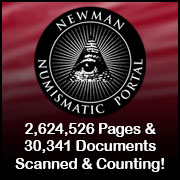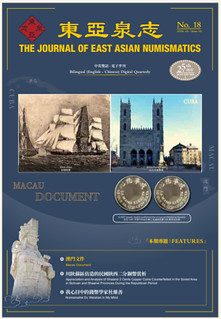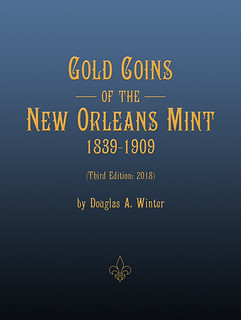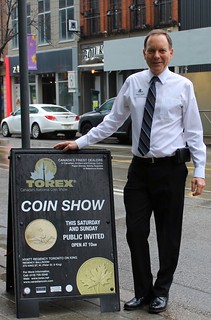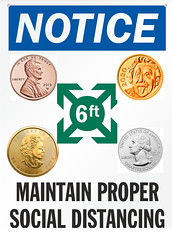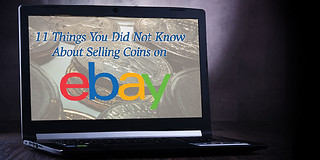
About UsThe Numismatic Bibliomania Society is a non-profit association devoted to the study and enjoyment of numismatic literature. For more information please see our web site at coinbooks.org SubscriptionsThose wishing to become new E-Sylum subscribers (or wishing to Unsubscribe) can go to the following web page link MembershipThere is a membership application available on the web site Membership Application To join, print the application and return it with your check to the address printed on the application. Print/Digital membership is $40 to addresses in the U.S., and $60 elsewhere. A digital-only membership is available for $25. For those without web access, write to: Charles Heck, Treasurer
AsylumFor Asylum mailing address changes and other membership questions, contact Chuck at this email address: treasurer@coinbooks.org SubmissionsTo submit items for publication in The E-Sylum, write to the Editor at this address: whomren@gmail.com BUY THE BOOK BEFORE THE COINSale Calendar |
- WAYNE'S WORDS: THE E-SYLUM MAY 10, 2020
- KOLBE & FANNING SALE 156 ANNOUNCED
- NEW BOOK: GREEK, ROMAN PROVINCIAL COINS - LYDIA
- JOURNAL OF EAST ASIAN NUMISMATICS #18
- ANS ANNOUNCES GREEK COIN HOARDS DATABASE
- AUDIO: MARK ANTONY
- VIDEO: 2006 ST. PATRICK COINAGE COAC
- A WISTFUL LOOK AT RED BOOK COIN PRICES
- COLIN NARBETH (1929-2020)
- STACK’S FIXED PRICE LISTS ON NEWMAN PORTAL
- VIDEO: GLENN B. SMEDLEY INTERVIEW
- 1792 MORRIS SILVER CENTER CENT FINAL THOUGHTS
- NLG 2020 WRITERS' COMPETITION NOW OPEN
- CATCHING UP WITH DOUG WINTER NUMISMATICS
- CORONAVIRUS UPDATES: MAY 10, 2020
- NOTES FROM E-SYLUM READERS: MAY 10, 2020
- URAM AND TUCKER REAPPOINTED TO CCAC POSITIONS
- VOCABULARY TERM: MAKER’S MARK
- EDWARD H. FISH
- HARVEY STACK'S NUMISMATIC FAMILY, PART 69
- MORE ON EDDIE ‘J.J. TEAPARTY’ LEVENTHAL
- ANS MONEY TALKS: U.S. CIRCULATING COUNTERFEITS
- NUMISMATIC NUGGETS: MAY 10, 2020
- THE COINS TELL THEIR STORY BEST
- USEFUL NUMISMATIC RESOURCES
- WHY WERE 1883 NICKELS ISSUED WITHOUT CENTS?
- WEST VIRGINIA ‘CREATE A QUARTER’ ART CONTEST
- THE ERROR THAT WASN'T
- CIVIL WAR ERA SANITARY FAIR NUMISMATICA
- THE TRISTRAM COFFIN MEDAL
- VICTORIA CROSS NOT MADE FROM CAPTURED GUNS
- THE MEMENTO MORI MEDAL
- IRAN'S CURRENCY CHANGE
- ITALIAN TOWN ISSUES ‘DUCATI’ BANKNOTES
- TENINO REVIVES WOODEN MONEY
- FAUX DOUGH: MOVIE PROP MONEY
- THE QUEEN'S STAMP COLLECTION
- CHINA’S DIGITAL CURRENCY
- LIFE-SAVING COINS
- UNCLAIMED PROPERTY REUNITES COINS WITH OWNER
- LOOSE CHANGE: MAY 10, 2020
- HOUSE BEAUTIFUL ON PENNY FLOORS
- FEATURED WEB SITE: ROBERT A. SIEGEL AUCTIONS
Click here to access the complete archive
Click here to unsubscribe (scroll down)
To comment or submit articles, reply to whomren@gmail.com
Content presented in The E-Sylum is not necessarily researched or independently fact-checked, and views expressed do not necessarily represent those of the Numismatic Bibliomania Society.
WAYNE'S WORDS: THE E-SYLUM MAY 10, 2020
 New subscribers this week include: New NBS member Borys Zaidman of Odessa, Ukraine; Richard Lobel of Coincraft, Ernie King and Andrzej Szwanke. Welcome aboard! We now have 6,114 subscribers.
New subscribers this week include: New NBS member Borys Zaidman of Odessa, Ukraine; Richard Lobel of Coincraft, Ernie King and Andrzej Szwanke. Welcome aboard! We now have 6,114 subscribers.
Thank you for reading The E-Sylum. If you enjoy it, please send me the email addresses of friends you think may enjoy it as well and I'll send them a subscription (but let me know if they are located in the European Union). Contact me at whomren@gmail.com anytime regarding your subscription, or questions, comments or suggestions about our content.
This week we open with a numismatic literature sale, a new book, a new journal issue, three updates from the American Numismatic Society, and a wistful look at old coin prices.
Other topics this week include fixed price lists, the Morris 1792 silver center cent, coronavirus updates from across the hobby, Glenn Smedley, Ed Leventhal, circulating counterfeit coins, numismatic detective work, Civil War sanitary fairs, the Tristram Coffin medal, community currency, Tenino's new wooden money, movie money, life-saving coins and penny floors.
To learn more about Nathaniel Paine’s Remarks on the Early Paper Currency of Massachusetts, Really Big Money, tunnel medals, maker's marks, the Numismatic and Antiquarian Society of Philadelphia, V E Day, the 1823/2 quarter, Snowden's cents-less coinage, what Victoria Cross medals probably AREN'T made of, Ducati banknotes, and the Error That Wasn't, read on. Have a great week, everyone!
Wayne Homren
Editor, The E-Sylum
KOLBE & FANNING SALE 156 ANNOUNCED
Kolbe & Fanning's next numismatic literature sale will close May 30, 2020. Here's the announcement. -Editor
KOLBE & FANNING ANNOUNCE MAY 30 BOOK AUCTION
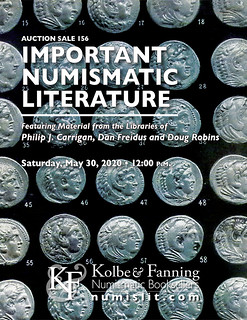 Kolbe & Fanning Numismatic Booksellers are announcing our Sale 156, which will be held on Saturday, May 30, 2020. The 419-lot sale includes a remarkable selection of books on ancient, world and U.S. numismatics, including
material from the libraries of Phil Carrigan, Dan Freidus, and Doug Robins. The sale features an especially diverse selection of material, perhaps most notable for rare and unusual American publications, but also including a number of infrequently
encountered and desirable works on ancient and foreign coins and medals.
Kolbe & Fanning Numismatic Booksellers are announcing our Sale 156, which will be held on Saturday, May 30, 2020. The 419-lot sale includes a remarkable selection of books on ancient, world and U.S. numismatics, including
material from the libraries of Phil Carrigan, Dan Freidus, and Doug Robins. The sale features an especially diverse selection of material, perhaps most notable for rare and unusual American publications, but also including a number of infrequently
encountered and desirable works on ancient and foreign coins and medals.
Some highlights of the sale include:
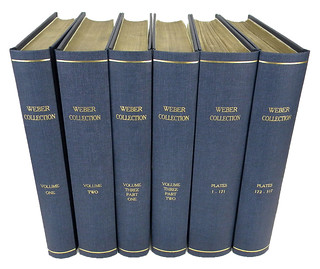
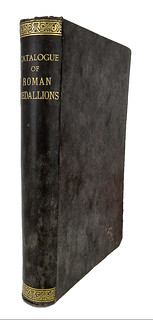
Lots 20 and 25
Lot 20: a freshly bound set of Forrer’s Descriptive Catalogue of the Collection of Greek Coins Formed by Sir Hermann Weber...
Lot 25: Grueber’s 1874 catalogue of Roman Medallions in the British Museum, with 66 autotype plates
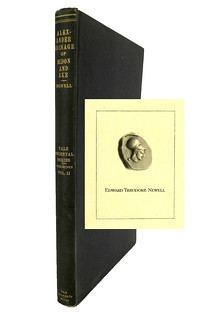
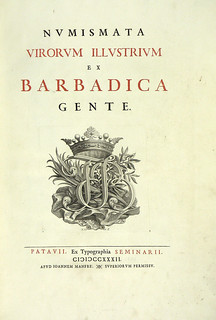
Lots 43 and 75
Lot 43: Edward T. Newell’s own copy of his 1916 The Dated Alexander Coinage of Sidon and Ake, interleaved and extensively annotated.
Lot 75: the majestic 1732 Numismata Virorum Illustrium ex Barbadica Gente, bound with the rare 1760 supplement with five additional plates annotated.
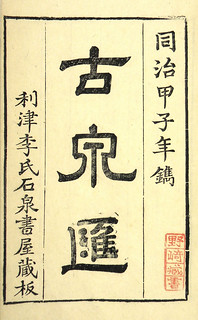
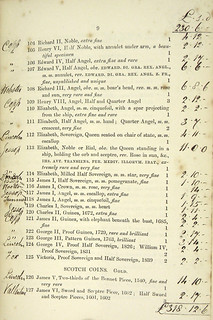
Lots 129 and 154
Lot 129: Li Zuoxian’s classic 20-volume compendium on Chinese coins, the Gu Quan Hui (also transliterated as Ku Ch’üan Hui), complete with the supplementary Xu Quan Hui (Hsu Ch’üan Hui)
Lot 154: a remarkable bound volume of twelve 19th-century British auction catalogues, including two of the utmost rarity, from the library of Terence Robertson
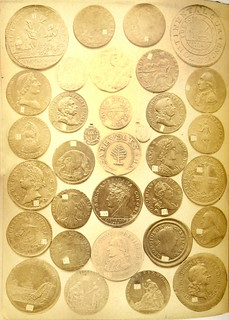
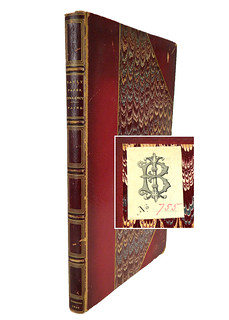
Lots 244 and 339
Lot 244: Dr. Charles Clay’s very rare 1864-1868 Manchester Numismatic Society serial, with the earliest photographic plates to appear in a numismatic journal, which depict American colonial coins in addition to other issues
Lot 339: Charles Bushnell’s extra-illustrated copy of Nathaniel Paine’s rare 1866 Remarks on the Early Paper Currency of Massachusetts, another pioneering use of photography in a numismatic work
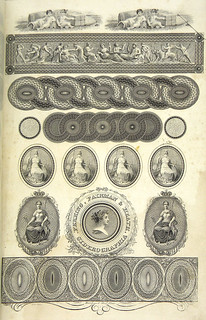
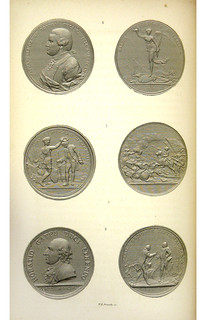
Lots 343 and 411
Lot 343: a very rare 1821 Jacob Perkins publication on the Prevention of the Forgery of Bank Notes, originally presented to a member of the Perkins family and previously thought to be unique
Lot 411: Thomas Wyatt’s 1848 work on American medals presented to military figures, with unusually well-preserved plates engraved with a medal-ruling machine.
The printed catalogue has been mailed to active customers. A PDF of the printed catalogue has been posted to our main website at numislit.com for those who prefer that format. Bids placed via post, email, fax or phone must be received by Friday, May 29, the day before the sale, in order for them to be processed. Advance absentee bids may also be placed at any time online at bid.numislit.com; live internet bidding will be available during the sale itself through the same platform.
Kolbe & Fanning Numismatic Booksellers LLC is a licensed and bonded auction firm in the State of Ohio. For more information, please see the Kolbe & Fanning website at bid.numislit.com or email David Fanning at df@numislit.com.

NEW BOOK: GREEK, ROMAN PROVINCIAL COINS - LYDIA
David Sundman passed along an announcement about this new book on Greek and Roman provincials. Thanks! -Editor
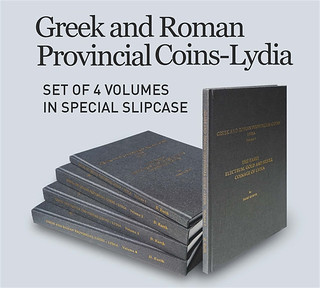 Greek and Roman Provincial Coins - Lydia
Greek and Roman Provincial Coins - Lydia
Author: Kurth, Dane
Publisher: Ege Yayinlari
ISBN: 9786057673244
Publication Date & Place: 2020 / Istanbul
Set of 4 cloth hardbound volumes in a slipcase. Limited edition. 1157 pages in total, 6278 coins in 466 plates, monograms, bibliography, and indices.
Vol. I xix + 89 pages, 678 coins in 37 plates
Vol. II ix + 326 pages, 1703 coins in 131 plates
Vol. III ix + 332 pages, 1931 coins in 141 plates
Vol. IV ix + 364 pages, 2101 coins in 157 plates
The "Greek and Roman Provincial Coins" of Lydia is the first corpus of coins of Lydia which, unlike BMC, SNG Copenhagen, SNG München, Gökyildirim, Von Aulock, Mionet etc, is not limited to examples in single collections. The new work of Lydian coins, comprising of four volumes - one for electrum, gold and silver, the other three covering the vast variety of bronze civic and provincial Lydian coins from Kroisos to the Valerian family, documents coins in public, national and private collections as well as hundreds of new varieties which have been sold up to Autumn 2019.
Approximately 7,500 Lydian coins are listed (approx. 95% of which are illustrated), with additional pages of indices, lists of types, monograms, references and sources make the new four-volume GRPC corpus an indispensible work for dealers and collectors who aim to describe their coins with precision.
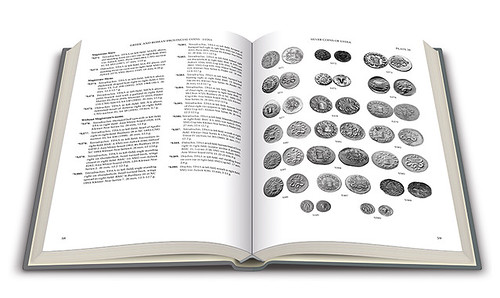
Publishers Comments / John Aiello
General Introduction / Dane Kurth
The Early Electum, Gold and Silver Coinage of Lydia / Italo Vecchi
The Post-Achaemenid Gold and Silver Coinage of Lydia / Dane Kurth
- Catalogue of Electrum and Gold Coinage of Lydia
- Catalogue of Silver Coins of Lydia
- Monograms
- Bibliography and Abbreviations
- Index of Reverse Types of Gold and Silver Coins
- Index of Symbols on Gold and Silver Coins
- Index of Kings, Satraps and Emperors on Gold and Silver Coins
- The Bronze Coinage of Lydia - Introduction / Dane Kurth
Catalogue of Bronze Coinage of Lydia
Monograms
Bibliography and Abbreviations
For more information, or to purchase, see:
Greek and Roman Provincial Coins - Lydia (https://www.zerobooksonline.com/en/greek-and-roman-provincial-coins-lydia_29_60490.html?r=10)
JOURNAL OF EAST ASIAN NUMISMATICS #18
David Sundman passed along the 18th issue of The Journal of East Asian Numismatics (JEAN). Thanks. Here's the table of contents. -Editor
Macau Document
Chinan Fan / Wei-Yu Ho[USA]
Appreciation and Analysis of Shaanxi 2 Cents Copper Coins Counterfeited in the Soviet Area in Sichuan and Shaanxi Provinces During the Republican Period
Wu Tao[Shaan Xi]
Numismatist Du Weishan In My Mind
Yuan Shuiqing[XI'an]
DEPARTMENTS
Book Reviews
An Essential Book for Professional and Amateur Collectors of Coins and Medals Made from Hand-Engraved Dies—Review of Inheritance: The Hand Engraving of Coin and Medal Dies
Zhou Bian[Shanghai]
The First Work to Uncover the Secret of Coins Minted by Secret Anti-Qing Societies at the End of the Qing Dynasty: Review on the Study on Coins Minted by Secret Anti-Qing Societies at the end of the Qing Dynasty
Zhou Bian[Shanghai]
Numismatics Newsletter
World-Class Collection Banknotes Available Online
Smithsonian National Museum of history
Josiah K. Lilly Jr “Room of Gold”
Smithsonian National Museum of history
Really Big Money
Smithsonian National Museum of history
49th World Money Fair Berlin 2020 Impressions
Oliver Strahl[Germany]
Think Long Term
Jeff Garrett[USA]
In Memorial of Du Weishan
Dai Zhiqiang[Beijing]
A Study on the Hidden Marks on the Mexican 8 Reales [Eagle Dollar] Minted from 1848 to 1849
Jin Ming[Anhui]
Dragon Boat [Duan Wu] Festival and Related Chinese Numismatic Charms
Zhou Bian[Shanghai]
Casilear Printing Specimen of 1-Yen National Bank Note
Oley Kawani[Japan]
A French City’s Asian Coin Collection
Bruno Collin[France]
COLUMNS
Newly-Discovered 1988 China Panda 1oz Platinum Sample
Ge Zukang[Hangzhou]
The Attribution of Sino-Kharosthi Coins
Zhou Ti[Urumqi]
My View on Taiwan Coins
Chou Chienfu[Taibei]
Minting and Appreciation of the First Large Irregular Brass Medal in Modern China
Zhang Jun[Shanghai]
Invasion Notes
Jan Olav Aamlid[Thailand]
The Japanese Dating Systems for Coinage
Jay Turner[USA]
To read the complete issue, see:
The Eighteenth Issue of JEAN (https://issuu.com/jeandigitala1/docs/the_eighteenth_issue_of_jean)

ANS ANNOUNCES GREEK COIN HOARDS DATABASE
The ANS is announcing a new online database of Greek coin hoards. -Editor
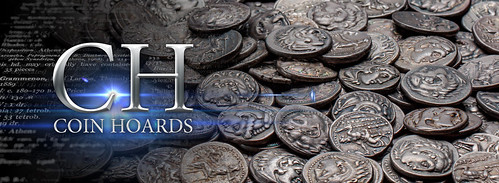
The American Numismatic Society is pleased to announce the launch of CoinHoards (coinhoards.org), a new web-based, linked open data tool for research in ancient Greek numismatics and ancient economies.
Coin Hoards is a component of the National Endowment for the Humanities-funded Hellenistic Royal Coinages (numismatics.org/hrc) project developed by the American Numismatic Society (ANS). An innovative research resource, CoinHoards provides primary data and other information on 2,387 hoards of coins produced by Greeks and other non-Roman peoples in the Mediterranean and adjacent regions between ca. 650 and 30 BCE. In addition to a basic description, users will find on the page devoted to each hoard mapping tools for the findspot and mint(s) where the coins found in the hoard were produced, bibliographical references, and a list of the hoard contents. These tools will allow users to compare and contrast circulation patterns of coinage in various parts of the Mediterranean world over time. Where possible, each type of coin listed is linked to a typological description, such as those found on PELLA (numismatics.org/pella), Seleucid Coins Online (numismatics.org/sco), and Ptolemaic Coins Online (numismatics.org/pco). Additional links are provided where possible to relevant resources associated with the hoard, which might include the MANTIS record of individual coins from the hoard held in the ANS collection, ANS publications, the notebooks of Edward T. Newell, and associated correspondence, notes, and archival material.
The current version of CoinHoards is based on the print publication Inventory of Greek Coin Hoards, edited by Margaret Thompson, Otto Mørkholm, and Colin Kraay published in 1973 by the ANS for the International Numismatic Commission. Future versions of CoinHoards will incorporate material from the print publications Coin Hoards, vols. 1–10, published by the Royal Numismatic Society, and more recently by both the Royal Numismatic Society and the ANS.
As noted by project co-director, Dr. Peter van Alfen, “the launch of CoinHoards is a remarkable step forward in our ability to trace circulation patterns of ancient coinage and thereby gain greater in- sight into patterns of trade and other types of economic interaction. This new website allows users to conduct in-depth research on scores of related hoards and their contents in just a few minutes, saving hours or even days of research time.”
To visit the CoinHoards site, see:
http://coinhoards.org/
AUDIO: MARK ANTONY
The American Numismatic Society has published a new episode of their podcast, The Planchet. -Editor
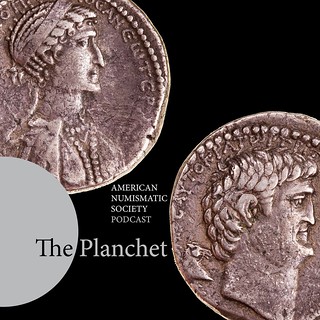 Mark Antony: A Rogue with Monetary Insight
Mark Antony: A Rogue with Monetary Insight
The second episode of The Planchet features guests Dr. Lucia Carbone, Assistant Curator for Roman Coins for the ANS, and Dr. Katie Cupello, expert on Mark Antony and Roman portraiture, as they talk about Antony, his many wives, political iconography, and his program of coinage in the Roman East.
Total Time: 69 minutes
The Planchet is available wherever you get your podcasts
For more information, or to listen, see:
The Planchet: The Podcast from the American Numismatic Society (http://numismatics.org/planchet/)
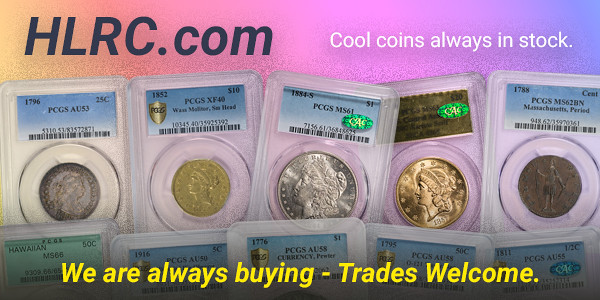
VIDEO: 2006 ST. PATRICK COINAGE COAC
The American Numismatic Society has also published videos of the 2006 Coinage of the Americas Conference on St. Patrick Coinage. Here's the announcement from their April 2020 E-News. -Editor
2006 COAC now fully uploaded to the ANS YouTube Channel
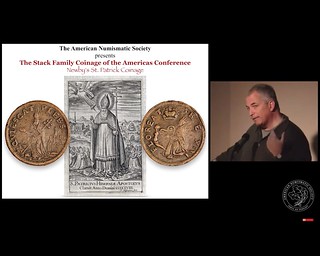 The 20th COAC, dedicated to Newby’s St. Patrick Coinage, was sponsored by the Stack Family and held at the Society’s former Fulton Street location on November 11, 2006. Thanks to Ray Williams, it was the first COAC ever to be filmed using
digital equipment.
The 20th COAC, dedicated to Newby’s St. Patrick Coinage, was sponsored by the Stack Family and held at the Society’s former Fulton Street location on November 11, 2006. Thanks to Ray Williams, it was the first COAC ever to be filmed using
digital equipment.
Speakers including Robert Heslip, Philip Mossman, Oliver Hoover, William Nipper, Brian Danforth, Louis Jordan, Roger Siboni and Vicken Yegparian cover a wide range of topics, such as the identification of the denomination(s) of the St. Patrick coppers, the method and author of their production, and the circulating media of the Anglo-American colonies in the 17th century.
To view the videos on the ANS YouTube Channel, see:
https://www.youtube.com/watch?v=0YdwHjdkYhk&list=PLYXyErJWMz65P-ioHf4K2KXY4ANkb-Kcy
To read the conference proceedings, see:
Mark Newby's St. Patrick coinage (http://numismatics.org/digitallibrary/ark:/53695/nnan146999)
A WISTFUL LOOK AT RED BOOK COIN PRICES
Dennis Tucker of Whitman Publishing submitted this article on coin prices in the first edition of the Guide Book of United States Coins. Thanks. -Editor
1892-S Morgan Dollar, Uncirculated, $15—No Haggling!
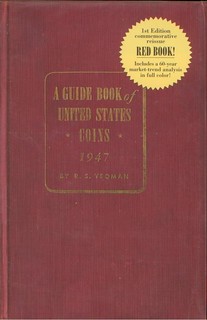 How would you like an opportunity to spend less than $100, and get a collection of coins worth $250,000?
How would you like an opportunity to spend less than $100, and get a collection of coins worth $250,000?
The following coins are for sale—prices firm, cash on the barrel head:
- 1880 Shield nickel, Unc — $8.00
- 1921-S Liberty Walking half dollar, Unc — $18.00
- 1926 Sesquicentennial commemorative half dollar, Unc — $2.50
- 1875-CC gold eagle, Unc — $55.00
Seems like a no-brainer! I might as well ask, “How would you like to rotate your tires and fill up your tank, and as a bonus you get a brand-new Lamborghini?”
Grab a copy of the 1947 Red Book, the first edition of the Guide Book of United States Coins. Then hop in your trusty time machine, and you can go back to find these prices in the rare-coin market of 74 years ago.
Happy Days Are Here Again
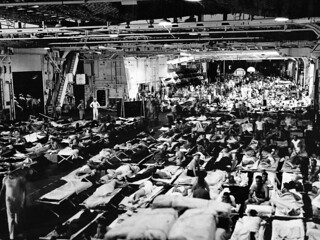 Imagine the year is 1947. World War II has been over for some time, and America’s economy is booming. The military mobilization that helped the Allies win the war has since repatriated millions of Americans: in Operation Magic Carpet,
running from June 1945 to September 1946, the War Shipping Administration brought 8 million service members home from Europe and the Pacific and Asian theaters. Now, back in the States, demand is much greater than supply for many consumer goods—but
manufacturers are happy to meet the challenge! Young couples are temporarily moving in with their parents while homebuilders hustle to ramp up the amount of available housing. (The average cost of a new home? $6,600, or about two-and-a-half times
the average yearly wage.) With the war over, federal expenditure is markedly down—comparing 1944 and 1947, government spending at all levels has dropped 75 percent—but U.S. citizens are spending more than twice as much on durable goods, overall
consumption is up nearly 25 percent, and private investment has more than doubled.
Imagine the year is 1947. World War II has been over for some time, and America’s economy is booming. The military mobilization that helped the Allies win the war has since repatriated millions of Americans: in Operation Magic Carpet,
running from June 1945 to September 1946, the War Shipping Administration brought 8 million service members home from Europe and the Pacific and Asian theaters. Now, back in the States, demand is much greater than supply for many consumer goods—but
manufacturers are happy to meet the challenge! Young couples are temporarily moving in with their parents while homebuilders hustle to ramp up the amount of available housing. (The average cost of a new home? $6,600, or about two-and-a-half times
the average yearly wage.) With the war over, federal expenditure is markedly down—comparing 1944 and 1947, government spending at all levels has dropped 75 percent—but U.S. citizens are spending more than twice as much on durable goods, overall
consumption is up nearly 25 percent, and private investment has more than doubled.
Americans are buying household appliances, new cars, new homes. They’re also spending money on their hobbies—including collecting U.S. coins.
A Revolutionary New Book for a Fast-Growing Hobby
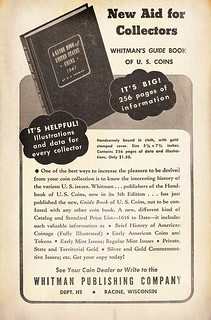 In the midst of all this economic growth and personal spending, Whitman Publishing finally debuted a new hobby reference that had been delayed by wartime paper rationing. It was in November 1946 that R.S. Yeoman’s Guide Book of United
States Coins—a retail-pricing version of the popular wholesale-market Handbook of United States Coins—made its first appearance. Now collectors had an annual guide to how much professional dealers were charging, on average, for every coin
produced since the start of the U.S. Mint in 1792.
In the midst of all this economic growth and personal spending, Whitman Publishing finally debuted a new hobby reference that had been delayed by wartime paper rationing. It was in November 1946 that R.S. Yeoman’s Guide Book of United
States Coins—a retail-pricing version of the popular wholesale-market Handbook of United States Coins—made its first appearance. Now collectors had an annual guide to how much professional dealers were charging, on average, for every coin
produced since the start of the U.S. Mint in 1792.
The first print run of the Red Book’s first edition totaled 9,000 copies. These sold so quickly that another 9,000 were printed in February 1947.
By 1959 collectors were buying more than 100,000 Red Books annually. The 1965 (18th) edition reached a peak in sales of 1,200,000 copies. The hobby market was going gangbusters, and that year the Red Book was ranked fifth on the list of best-selling nonfiction titles—ahead of Dale Carnegie’s How to Win Friends and Influence People (at no. 6) and John F. Kennedy’s Profiles in Courage (no. 9).
A Tribute to the Red Book
Perhaps even R.S. Yeoman couldn’t have imagined that today, with the Red Book in its 74th edition, collectors would have purchased well over 24 million copies. The guide book is a superstar of America publishing, one of the most popular nonfiction titles of all time. It’s even attained collectible status itself, with many hobbyists adding the latest hardcover to their collections each year. As with rare coins, supply and demand come into play: today an original copy of the 1st edition can command $1,200 to $1,500.
The sixtieth anniversary of the first Red Book was a fun year for Whitman Publishing; we debuted some great titles in 2006. The one that captured collectors’ imaginations the most might have been the 1947 Tribute Edition Red Book. This was a page-by-page exact recreation of the very first Guide Book of United States Coins. It also included a full-color section comparing the current hobby market with that of the 1940s.
This is where our wishful thinking for a time machine comes in. Just take a look at those 74-year-old coin prices!
$11 for a Proof trade dollar. $50 for a Clark, Gruber & Co. “Pikes Peak” five-dollar gold piece, in Uncirculated condition.
Today, if you’re not picky, $5 will buy you a fast-food lunch. In 1947 it would get you an early-1800s Draped Bust quarter in Fine, or an Uncirculated Flying Eagle cent from the 1850s.
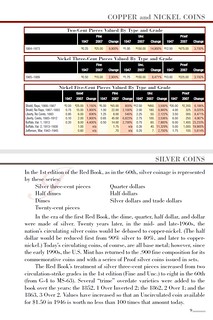
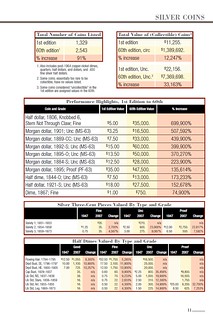
A collector who wanted to buy one of every coin and set valued in the first Red Book would have paid $167,970 for a circulated collection, or $219,609 in Mint State. In today’s market that would require more than $11 million and $45 million respectively.
One hobbyist who bought a copy of the 1947 Tribute Edition Red Book looked up a few favorite coins, and then, as he put it, “paged through to look and sigh over prices that are similar to or less than my son’s allowance.” Another wistful reader said, “It’s like time travel. $50 Pan-Pac Octagonal for $500 . . . I’ll take a whole roll, please!”
No matter which U.S. coins you collect, there’s much to learn by comparing today’s hobby with the hobby of yesterday. Plus it can be a heck of a lot of fun. Just don’t let it frustrate you too much. . . . ($3.75 for an Uncirculated 1909-S V.D.B. cent?!)
Now where did I leave my time machine...? -Editor
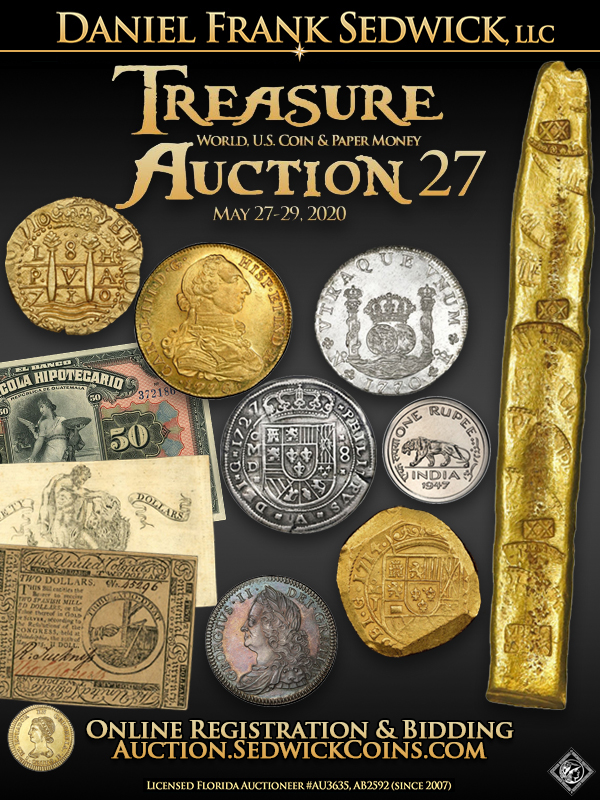
COLIN NARBETH (1929-2020)
Kavan Ratnatunga alerted me of the passing of Colin Narbeth, Founder and Life member No, 1 of the International Bank Note Society (IBNS). I've added images from the Colin Narbeth and Son web site. -Editor
Brian Ascroft of IBNS writes:
"I would just like to send my condolences to all to Colin Narbeth's family for their loss of a great man who started the IBNS along time ago that was life member No:1 which has given us all so much pleasure in our life with our collecting hobby, I had known him for such a long long time now and was a really very nice man. May he rest in peace."
From the IBNS site:
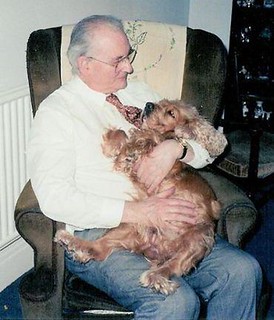 "Colin Narbeth, IBNS Life Member No. 1, was the founder of the IBNS in 1961. More than 50 years ago, Colin was one of the few enthusiasts scattered around the globe who were devoted to the collection of world paper money.
"Colin Narbeth, IBNS Life Member No. 1, was the founder of the IBNS in 1961. More than 50 years ago, Colin was one of the few enthusiasts scattered around the globe who were devoted to the collection of world paper money.
Colin began collecting banknotes (and many other things as well) as a schoolboy in the 1940s. During seven years in the Royal Navy he added a few pieces to his collection from his ports of call. After he left the navy, he became a newspaper reporter and began collecting paper money seriously, buying from the infrequent paper money offerings from the likes of Spink Limited and B.A. Seaby Limited in Britain and Jolie Coins in US. He was also busy writing to anyone whose name came to his attention as sharing a similar interest in paper money. In this way he became friends with other banknote pioneers like Dr. Walter Loeb, Dr. Arnold Keller (who proofread and corrected Narbeth’s first book on banknotes), and often swapped notes with them.
He helped launch “Stamp Weekly” and then moved to become a director of Stanley Gibbons International, where he started Stanley Gibbons Currency Limited, the first major British business dealing in paper money. He later left Gibbons to start his own banknote business, Colin Narbeth and Son Limited, which continues as a family business today. Colin has written numerous articles and some 20 books on a range of collecting subjects. In July 1961, Colin produced the first IBNS Journal on a hand-operated Gestetner printer, mailing it out to around 20 people. In addition to the IBNS, Colin [was] a Fellow of the Linnean Society and the Royal Philatelic Society, London."
From a May 9, 2020 IBNS email:
"In early May 2020, we learned of the passing of 90-year-old IBNS founder and Life Member #1 Colin Narbeth. While Colin was a consummate world paper money collector, it was just one of his many collecting interests. Colin passed on from age-related declining health and not from the coronavirus pandemic.
"Colin held many roles within the IBNS over the years. He was the inaugural Journal Editor from 1961 (Volume 1 Issue 1) through to 1970 (Volume 10 Issue 1) and took over the Editorship again from 1975 (Volume 14 Issue 1) through to 1979 (Volume 17 Issue 4). As the founder, he was also the first treasurer, secretary and auctioneer, although he quickly found others to take on these roles. He was also the IBNS President (1990-1992) for the 30th Anniversary of the International Bank Note Society.
"He also contributed a number of articles to the journal on as varied topics as "The Bank of England" and "Turks and Caicos" and wrote a number of books on collecting whether that banknotes, bonds and shares or stamps.
"The IBNS sends its heartfelt condolences to his two children and other family members and will dedicate the next issue of the IBNS Journal as a tribute to Colin Narbeth."
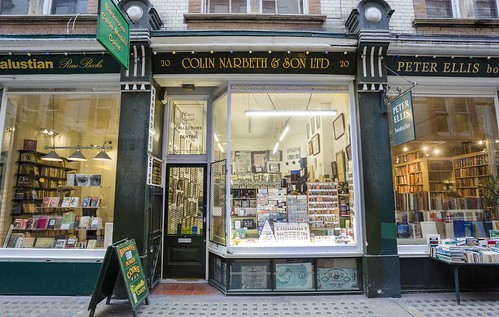
Richard Lobel of Coincraft submitted these thoughts. Thank you. -Editor
I was told today of the death of my very good friend Colin Narbeth. He was the founder and member number ‘1’ of the International Banknote Society and one hell of a nice guy. His death was not unexpected, as the last time I saw him he was at his 90th birthday do, rather frail looking, never-the-less, he still wanted to know ‘when were the drinks being served’. My kind of guy!
I had the honour of knowing him for about 50 years. He was honest and kind, something you don’t always get in dealers. I knew him when he set up Stanley Gibbons Collectables, backed by the mighty Stanley Gibbons name and cheque book. He revolutionised banknote collecting and dealing in this country. He brought banknote collecting into the light. He made banknotes reach a price level that attracted collector’s attention. He had been a journalist amongst other areas of expertise, so he knew how to get a journalist interested in a story and he used that ability to promote the hobby.
We did so many deals together over the years that it is hard to remember them all, some of them which come to mind are: the Rothman’s banknote promotion, the sale of the unique Philippines under Spanish rule banknotes that were thought to exist but were unknown until we found them. In the end they were sold to the Central Bank of The Philippines Museum. Or perhaps the time he sold me all the old 1930’s gambling chips that his boss Mick Michaels had bought from the Casino at Monte Carlo. Colin had sent the chips to Scotland Yard to have them tested to see if the early plastic was poisonous, they were not. But I stored them in cardboard boxes in my warehouse. When we came back, the chemicals in those early plastic was so strong that it had peeled the paint off the walls.
It was always fun to deal with Colin you never knew what was going to happen. But it was always a fair deal to both of you.
We used to go to IBNS meetings together, when they were held in Horseferry Road. He would come back and stay the night with us, sleeping on the sofa, as all the beds in the flat were taken. I was young and brash and he became my mentor, he taught me about business and about people. There are many dealers in coins and banknotes today, that at one time or another worked for Colin, at Stanley Gibbons. When Gibbons closed their collectable side and I must say they treated him abysmally. Colin wanted a job, so he joined my company, after all, his son and daughter were already working there. He was so knowledgeable and so willing to share his knowledge with everyone. After a while he left my company and opened his famous store ‘Colin Narbeth & Son’. With he was his son Simon and daughter Vanessa. The store is a London landmark for banknote collectors. Simon is still running it.
It has been a quite a few years since Colin was really active in the banknote business, but he always turned up for the IBNS Fair in the Autumn and it was nice to see and have a natter with him. Colin had so many other collections to keep him busy that banknotes were pushed aside. I am honoured to have known him and to have been able to call him a real friend of mine. I and the whole banknote business are going to miss this gentle giant we owe so much to him.
Richard Lobel, founder Coincraft, London, England
John and Nancy Wilson write:
"When we were in London in 1989 we visited his store. He was a very nice person who contributed greatly to the numismatic and world paper paper money field. His hard work in the International Bank Note Society was huge."
For more information on the International Bank Note Society, see:
https://www.theibns.org/
To visit the Colin Narbeth and Son web site, see:
https://colin-narbeth.com/

STACK’S FIXED PRICE LISTS ON NEWMAN PORTAL
Project Coordinator Len Augsburger provided the following report on Stack’s Fixed Price Lists on the Newman Numismatic Portal. -Editor
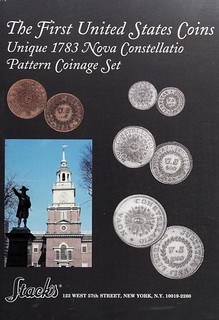 Fixed price lists (FPLs) are definition ephemeral, intending to quickly move inventory before moving on to the next edition. Few are saved unless containing useful articles or presenting specialized collections. This week Q. David Bowers
asked about a Stack’s FPL from 1940, and, while not immediately located on Newman Portal, a copy in the American Numismatic Society library was identified for future scanning. The Newman Portal contains a collection of about 40 Stack’s FPLs ranging
from 1947 to 1994.
Fixed price lists (FPLs) are definition ephemeral, intending to quickly move inventory before moving on to the next edition. Few are saved unless containing useful articles or presenting specialized collections. This week Q. David Bowers
asked about a Stack’s FPL from 1940, and, while not immediately located on Newman Portal, a copy in the American Numismatic Society library was identified for future scanning. The Newman Portal contains a collection of about 40 Stack’s FPLs ranging
from 1947 to 1994.
One interesting item is a 1994 FPL presenting the Garrett / Ford pattern set of the Nova Contestellatio pieces. These patterns were produced in 1783 under the direction of Gouverneur Morris, acting on behalf of the Confederation Congress, and are arguably the first coinage of the United States. The set was offered at $1.5 million, found no takers, and eventually landed in the collection of a “southern gentleman,” appearing on exhibit at the 2009 Whitman Philadelphia Expo. There are no doubt many other fixed price lists in the Stack’s series, and it is unlikely that a single library contains a complete set.
Link to Stack’s FPLs on Newman Portal::
https://nnp.wustl.edu/library/publisherdetail/516535?Year=1994&displayAmt=50
Link to Stack’s Nova Constellatio Pattern Set FPL:
https://archive.org/details/firstunitedstate0000stac
VIDEO: GLENN B. SMEDLEY INTERVIEW
These are selections from the David Lisot Video Library that feature news and personalities from the world of coin collecting. David has been attending coin conventions since 1972 and began videotaping in 1985. The Newman Numismatic Portal now
lists all David’s videos on their website at:
https://nnp.wustl.edu/library/multimediadetail/522852
Here's one on Glenn B. Smedley, namesake of the ANA's Glenn Smedley Memorial Award. -Editor
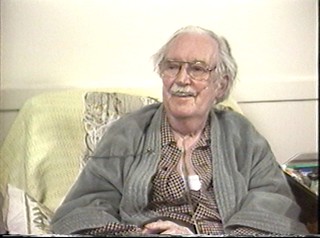 ARCHIVES: Interview with Glenn Smedley, 1986
ARCHIVES: Interview with Glenn Smedley, 1986
In 1986 on the program "Collector Talk" David Lisot interviews Glenn Smedley of the American Numismatic Association who collected Victor David Brenner medals and wrote "Numismatic Vignettes" for the ANA publication "The Numismatist".
An excerpt of the video is available for viewing on the Coin Television YouTube Channel at:
https://youtu.be/pMxMvyqGPSA

1792 MORRIS SILVER CENTER CENT FINAL THOUGHTS
In 2017 Stu and Maureen Levine, Rob Rodriguez and Tony Lopez published a study of various examples of the 1792 United States silver center cent (Judd-1), comparing the silver plugs in each. Stu published an update in 2019. Last week Rob Rodriguez issued a letter summarizing final thoughts on the project, which we're excerpting with permission here. For more information, see the complete document on the Newman Portal, linked below. -Editor
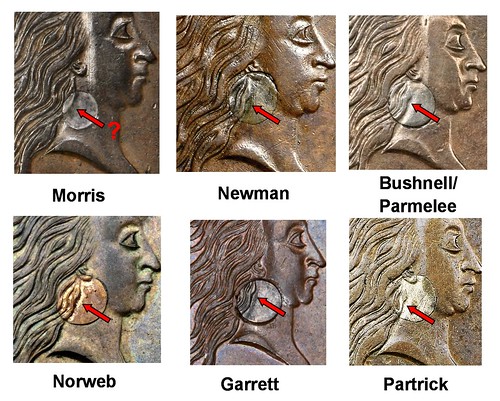
As team leader of the research project that investigated the 1792 Morris So-Called Silver Center Cent, it is an honor to recognize those who contributed much in bringing this project to fruition. Since November 2017, the research team that includes Stuart Levine, Maureen Levine, and Tony Lopez conducted extensive research on the 1792 Morris specimen culminating in the publication of a fifty-page analysis on the Newman Numismatic Portal, https://nnp.wustl.edu/library/book/538104. The study’s conclusion that the silver plug was inserted after striking and therefore not authentic, was publicly supported by twenty distinguished numismatic experts, https://nnp.wustl.edu/library/book/567273. The E-Sylum also reported on our findings as our investigation progressed.
In order to gain a better understanding of how the Morris So-Called Silver Center Cent was likely made and the amount of time that would have been required to accomplish the task, six Indian Head Cents were modified by inserting and hand-engraving a silver plug. Upon completion of our study, the six fabricated silver center cents were encapsulated and named after the respective recipients in acknowledgement of their efforts. Stuart and Maureen Levine received the #2 specimen; Tony Lopez #3; Jim Halperin, Co-Chairman, Heritage Auctions, #4; Ron Guth, founder of The Numismatic Detective Agency, #5; and, Ken Hopple, former Chief Coiner of the Carson City Mint, #6. I reserved the first specimen for myself after commissioning and paying for them to be made. The team very much appreciates the support it has received from the numismatic community.
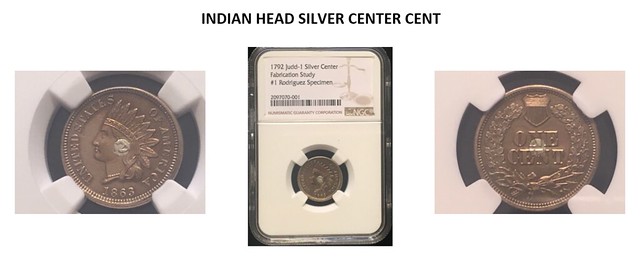
However, it is a great disappointment to the team that PCGS refused to accept multiple requests for meetings to discuss our Morris research findings. All along the team’s goal was simply to address the certification of a false specimen and achieve an appropriate solution that would serve the best interests of the numismatic community.
One person who deserves special recognition is the engraver, Jeanne LaShelle, who crafted the Indian Head Silver Center Cents. Throughout this process, I was restricted from disclosing her identity for security reasons. After reviewing our research and seeing the recognition it was receiving, she lifted this restriction at the Reno Coin Club meeting where I presented Ken Hopple with his specimen. Jeanne, who is very modest, is a dedicated and talented artist and has won recognition for her engraving. We believe the quality of her work speaks for itself.
With this final communication, it is now up to collectors and the industry to arrive at their own conclusion as to who has made the better argument. To date, we have never received any communication that details the PCGS position other than that they disagree with our conclusions. We believe we have provided a valuable service to the hobby.
Respectfully submitted,
Robert L. Rodriguez
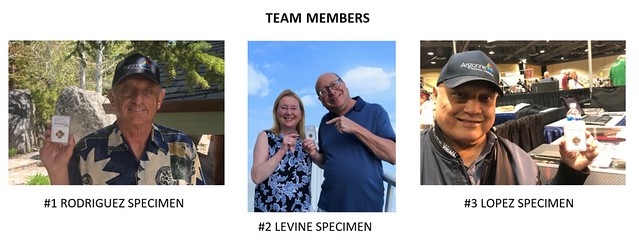
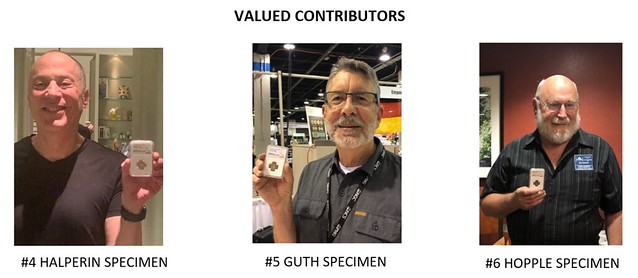
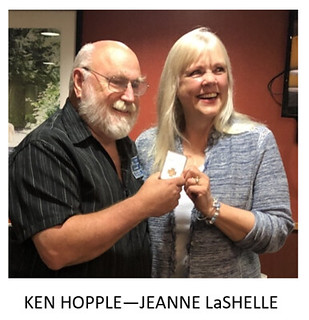
To read the study reports on the Newman Numismatic Portal, see:
1792 Silver And Non-Silver Center Cents: A Study (https://nnp.wustl.edu/library/book/538104)
1792 Silver And Non-Silver Center Cents: Responses from the Numismatic Community (https://nnp.wustl.edu/library/book/567273)
Final Thoughts -- 1792 Morris So-Called Silver Center Cent (https://nnp.wustl.edu/library/book/584154)
To read the earlier E-Sylum articles, see:
1792 SILVER AND NON-SILVER CENTER CENTS STUDY (https://www.coinbooks.org/v20/esylum_v20n48a18.html)
1792 SILVER AND NON-SILVER CENTER CENTS UPDATE (https://www.coinbooks.org/v22/esylum_v22n26a05.html)
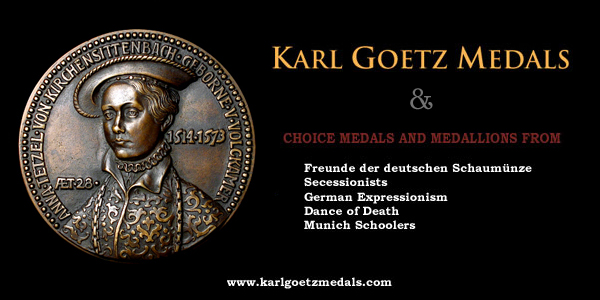
NLG 2020 WRITERS' COMPETITION NOW OPEN
Ron Guth, Executive Director of the Numismatic Literary Guild forwarded this press release about the organization's 2020 Writers’ Competition. Get your entries in, authors (and editors)! The NLG is not affiliated with the Numismatic Bibliomania Society, but many active researchers and writers are members of both organizations. (like myself). -Editor
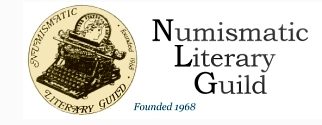 The Numismatic Literary Guild (NLG), a nonprofit organization composed of editors, authors, writers, bloggers and content producers who cover news and feature stories about all forms of money, medals and tokens as collectibles, has
announced its annual awards competition for 2020.
The Numismatic Literary Guild (NLG), a nonprofit organization composed of editors, authors, writers, bloggers and content producers who cover news and feature stories about all forms of money, medals and tokens as collectibles, has
announced its annual awards competition for 2020.
This year’s competition is being overseen by David Lange, the NLG Awards Coordinator. To be eligible for consideration in any of this year’s categories, entries must have been published, released, or posted on the Internet between May 1, 2019 and April 30, 2020.
All entries must be received no later than Wednesday, June 1, 2020. They should be sent to the contest coordinator at the following address: David W. Lange, NLG Awards Coordinator, c/o NGC, P.O. Box 4776, Sarasota, FL 34230.
Winners will be announced, and awards presented, at the 2020 NLG Bash and Awards Ceremony on Thursday, August 6, 2020, at the American Numismatic Association World’s Fair of Money® in Pittsburgh, PA. In the event the convention is cancelled because of the COVID-19 pandemic, the winners will be announced online and the awards will be sent in the mail.
If you submit an entry and cannot be at the awards ceremony in person, please indicate on your entry cover sheets the name of a designated person who can accept the award on your behalf and deliver it to you.
For information about joining the Numismatic Literary Guild, visit www.nlgonline.org/membership.
2020 Awards Competition Categories
NOTE: Each copy of each entry must be accompanied by a cover sheet. Please no paper clips or rubber bands --- these tend to become separated at some point. The cover sheets should be stapled directly to the front cover of the entry (exceptions may be made for hardcover books or catalogs).
Only one entry per category is allowed per submitter. Each submission must be accompanied by a cover sheet or label attached to each entry copy and containing the following information:
- CATEGORY NUMBER
- CATEGORY TITLE
- NAME OF PUBLICATION
- TITLE OF SUBMISSION
- DATE OF PUBLICATION
- NAME, ADDRESS, TELEPHONE NUMBER AND EMAIL ADDRESS OF ENTRANT
- NAME, ADDRESS, TELEPHONE NUMBER AND EMAIL ADDRESS OF AUTHOR IF DIFFERENT THAN ENTRANT
1. BEST SPECIALIZED BOOKS (Three printed copies are required for each entry, unless the entry is an e-book exclusively)
a. United States or Early American Coins
b. Ancient or Medieval Coins (pre-1500)
c. World Coins (1500 to Date)
d. United States Paper Money
e. World Paper Money
f. Tokens & Medals
g. Numismatic Investment or Marketplace
h. Numismatic History or Personalities
2. BOOK OF THE YEAR (Books submitted in the specialized categories are automatically considered for Book of the Year, and submitting additional copies is not required.)
This is the printed or electronic media work having the greatest potential impact on numismatics. Criteria include overall reader appeal, research quality, photographic and graphic excellence, cover and typography where applicable.
3. NUMISMATIC FEATURE ARTICLES (Three copies are required for each entry.)
a. Early American Coins (includes all non-U.S. Mint issues)
b. U.S. Coins (1792 to Date)
c. Ancient or Medieval Coins (pre-1500)
d. World Coins (1500 to Date)
e. U.S. Paper Money
f. World Paper Money
g. Tokens & Medals
h. Numismatic Investment or Marketplace
i. Numismatic History or Personalities
j. James L. Miller Memorial Award - Article or Story of the Year
(Articles submitted in the specialized categories are automatically considered for this award, and submitting additional copies is not required.)
4. NUMISMATIC COLUMNS (Three copies each of three different columns are required.)
a. Early American Coins (includes all non-U.S. Mint issues)
b. U.S. Coins (1792 to Date)
c. Ancient or Medieval Coins (pre-1500)
d. World Coins (1500 to Date)
e. Paper Money
f. Tokens & Medals
g. Numismatic Investment or Marketplace
h. Ed Reiter Memorial Award For Best Column - Numismatic Publications
(Columns submitted in the specialized categories are automatically considered for this award, and submitting additional copies is not required.)
i. The Maurice M. Gould Memorial Award for Best Column - Non-Numismatic Publications
(Columns submitted in the specialized categories are automatically considered for this award, and submitting additional copies is not required.)
5. PERIODICALS (Three copies each of three different issues are required.)
a. Best Investment Newsletter
Criteria include overall reader appeal, quality of research and writing, and graphics, as applicable.
b. Best Professional Periodical
To be submitted by the publisher or editor of any daily, weekly, monthly, quarterly or annual for-profit numismatic publication in the U.S. or overseas. Criteria include overall numismatic appeal, features, departments, graphics, journalistic and
editorial excellence as applicable.
c. Best Club or Not-for-Profit Periodical – Large Circulation
Open to any local, regional, national or international not-for-profit numismatic organization in the U.S. or overseas having a circulation of more than 20,000 per issue.
d. Best Club or Not-for-Profit Periodical – Small Circulation
Open to any local, regional, national or international not-for-profit numismatic organization in the U.S. or overseas having a circulation less than 20,000 per issue.
6. WEBSITES (Submit links to entry pages or three printed copies of selected entry pages.)
a. Best Online News Website
b. Best Dealer or Industry Website
c. Best Non-Trade Website
This category is for web sites maintained by coin clubs and other non-commercial organizations and individuals devoted to the coin hobby.
d. Best Numismatic Social Media Platform or Coin Collector Forum
The award will be presented for the best numismatic-themed page or feed posted on a collector forum site (or message board) or social media site such as Facebook, Instagram, Twitter or Google Plus. Entries will be judged based on the quality of
articles, external links, and graphics posted. Audience engagement also will be considered by the judges..
e. Best Blog
This award recognizes the best interactive blog that communicates information and personal commentaries about the numismatic hobby.
7. AUCTION OR FIXED-PRICE CATALOGS (Submit three copies of each entry.)
Criteria include cover design, overall eye appeal, format, graphics and layout, research and quality of description. Entries may be submitted by auction firm, auctioneer or cataloger. (NOTE: LIMIT OF ONE CATALOG FROM EACH AUCTION FIRM PER CATEGORY).
a. Best U.S. Coin Auction Catalog
b. Best World Coin Auction Catalog
c. Best Paper Money Auction Catalog
d. Best Book or Exonumia Auction Catalog
8. AUDIO-VISUAL
a. Radio (Entry must include three copies of a standard-size CD, flash/thumb drive or URL of a story or feature report or three selections from continuing series, accompanied by written statement citing date(s) of broadcast, call
letters and location of radio station.)
Best news story, feature report or continuing series involving numismatics.
b. Audio (Entry must include three copies of a standard-size CD or flash/thumb drive of the audio, accompanied by a written statement citing date(s) of first use.)
Best non-broadcast, audio program involving numismatics. Includes audio tracks from numismatic slide shows, educational tapes, audio newsletters or podcasts.
c. Television (Entry must include three standard-size DVD or flash/thumb drive of the television story or feature report broadcast or three selections from a continuing televised series. They must be accompanied by a written statement
citing date(s) of broadcast, call letters and location of station.)
Best spot news story, feature report or continuing series involving numismatics shown on television or cable.
d. Short Video – Commercial or Non-Commercial (Entry must include three copies of a standard-size DVD, film or flash/thumb drive used in presentation.)
This category is for video presentations of 10 minutes or less. Best non-broadcast slide film, PowerPoint®, movie film or videotape presentation involving numismatics made for educational purposes.
e. Long Video – Commercial or Non-Commercial (The submission criteria are the same as for 8d.)
This category is for video presentations lasting longer than 10 minutes.
f. Still Photography (Entry must include three sets of five examples each in either hard copy or electronic format.)
This applies to either commercial or non-commercial photography of numismatic objects, and entries may include examples of both.
g. Software or App (For physical media three copies of the work need to be submitted. For digitally distributed software or apps, three copies must also be provided, and if the entry is distributed on the Android or Apple store, written
instructions must be provided about how to locate and download the app. Each entry must be accompanied by a written statement citing date(s) of first use.)
Best presentation of new numismatic-related software or mobile application published in CD-Rom, DVD, App Store or any other electronic format or electronic delivery system.
9. SPECIAL AWARDS
a. Lee Martin Founder's Award - Best All-Around Portfolio (Only one copy of the portfolio entry needs to be submitted and may be submitted as PDF files on a flash/thumb drive. Items included in the portfolio may also be submitted in
other relevant categories at entrant’s option.)
Collection of writings and/or photographs and related items demonstrating numismatic writing ability and versatility published within the contest year. The emphasis is on quality, not quantity, and organization and presentation will count as heavily
as volume.
b. Clement F. Bailey Memorial Award (Three copies each of at least one but not more than three writing samples must be included. Nominees are supplied solely by numismatic publishers.)
This award was endowed by Jim Miller of Miller Magazines in memory of an especially beloved member of the numismatic writing community and NLG founder, Clement F. Bailey. It recognizes excellence among new writers in numismatics whose first
published writings in this field appeared in hobby publications during the previous year.
c. The Ribbit
This award recognizes an individual who has achieved prominence in numismatics while maintaining approachability, a sense of humor and essential modesty. The winner is selected by the previous year’s recipient.
d. The Clemy
The winner of this award, the Guild’s highest honor, is chosen by the previous year’s recipient from a list of nominees provided by the NLG Board of Directors.
NLG reserves the right to limit the number of plaques for any given entry, with the number to be determined at its discretion. NLG will provide plaques only for the persons named in an entry when it is originally submitted. Winners living in countries other than the United States, Canada and Mexico will receive certificates and cash awards, rather than plaques. The cash award will be $50 for first-place winners.
To visit the NLG web site, see:
https://www.nlgonline.org/
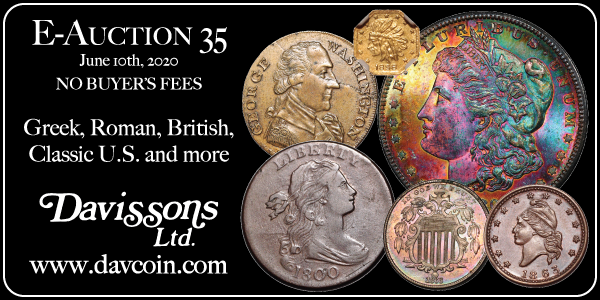
CATCHING UP WITH DOUG WINTER NUMISMATICS
On May 7, 2020 published an email post with information on his firm's recent activities and the state of the numismatic market. With permission we're republishing it here. You can sign up get the newsletter on the web site. -Editor

We are entering our ninth week of quarantine (but who’s counting…). Doug, Irma, and Earl are still in California while Jenna is running the Portland office. We’ve established a comfortable routine with Doug working a few hours in the morning and a few in the mid-afternoon. Jenna is keeping operations running smoothly at DWN/PDX. We are adding coins to inventory, and shipping two days per week (Monday and Wednesday). It’s not “normal” but it’s pretty darn close…
Despite some really scary economic news, the coin market continues to chug along. If a coin is popular, reasonably priced (less than $10,000), and it's choice, it will find a buyer. Maybe not as quickly as it would have three months ago but it will sell. The market remains collector based and this is good. In 2008, after the mortgage crisis hit hard, I had numerous dealers and collectors frantically call me looking to sell coins. This time around, I see next to no panic selling. The market has solid fundamentals. Plus, the spike in gold has certainly helped.
As I’ve previously mentioned, the biggest problem in the coin market right now is the broken supply chain. It was never easy for me to find quantities of DWN-esque coins, but at least I could go (kicking and screaming) to a show and come home with 25 coins; maybe even more if I was lucky. I can’t see me going to a show before the Fall and this means that I will have to continue buying one coin here and one coin there. What it also means is that you, the collector, will see fewer interesting coins in 2020. This means that you should take advantage of buying opportunities when they arise.
If you have coins for sale, please run them by me. If they were purchased from DWN, I can make a sight-unseen offer. If they come from another dealer, I’ll need to see them in person to make an offer. Warning: if you have coins stored in a safety deposit box at your local bank, be prepared to make an appointment to retrieve them and be prepared not to be able to do this easily. We recently had a client wait nearly two weeks (!) until he was able to get three reasonably inexpensive coins out of his sdb. Again, the “new normal.”
We are putting the finishing touches on an updated 2020 version of the New Orleans gold book. While the book isn’t radically updated (as the 2018 edition was) there are some significant changes. We are intentionally making an extremely limited run (less than 100 books) to make it a numismatic collectible and because we realize that most of you are fine with a slightly-out-of-date 2018 edition. That said, if you’d like a copy, let us know via email.
Doug is working on a May article (which will be of interest to San Francisco gold collectors), and a series of blogs which will be posted on the site as soon as they are finished. They’ll be interesting and you’ll want to read them.
While only a limited number of new coins have been added to the site in the last 30 days, we’ve sold some amazing coins. This includes a number of six-figure Pioneer/Territorial issues, a few Condition Census half eagles from the Southern branch mints, two or three amazing Liberty Head eagles, and some very special Proof gold. Please note that we work closely and very confidentially with a number of very serious collectors and many of the really spiffy coins we handle never make it to the site.
We all hope you are your family are safe and healthy. If you’d like to play coins, DWN is here for you and we invite you to reach out by phone or email.
Thanks for your time and we always appreciate your business and your support.
-Doug, Irma, Jenna, and Earl (CFO; Chief Fetch Officer)
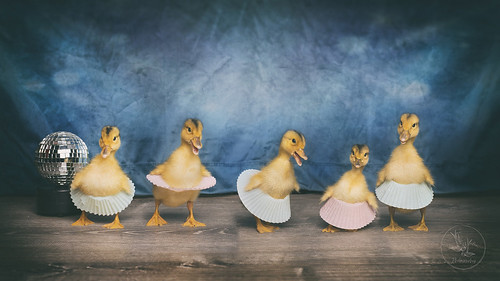
Jenna's "urban farm" recently hatched Silver Appleyard ducks, and she couldn't resist.
OK, bibliophiles - you've been forewarned. Contact DWN for more information on the New Orleans book. -Editor
To visit the DWN web site, see:
https://raregoldcoins.com/
To read an earlier E-Sylum article, see:
NEW BOOK: GOLD COINS OF NEW ORLEANS MINT 3RD ED. (https://www.coinbooks.org/v21/esylum_v21n38a02.html)
CORONAVIRUS UPDATES: MAY 10, 2020
Here's the latest compilation of coronavirus updates from readers, organizations and companies. -Editor
Summer Torex Cancelled (April 29, 2020)
I missed this announcement when it first came out. -Editor
"This summer’s Torex show, slated for June 27-28 in Toronto, is cancelled due to the uncertainty surrounding the COVID-19 pandemic and the easing of social-distancing restrictions in the coming months.
"The move was announced on April 18 by Torex executive director and owner Brian Smith, who said it’s “imperative that I follow the lead and advice of Toronto Mayor John Tory’s office and not host any events in June 2020.”
“Health and safety are paramount at Torex,” said Smith, who added the June 2020 Torex Auction “will still go on as scheduled but online only.”"
To read the complete article, see:
Summer Torex cancelled due to COVID-19 (https://canadiancoinnews.com/summer-torex-cancelled-due-to-covid-19/)
Oxford Numismatic Society (May 2, 2020)
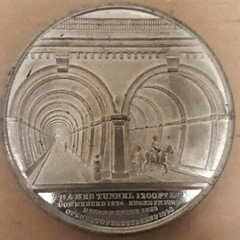
David Pickup sent along this report from the Oxford Numismatic Society. Thanks. -Editor
Oxford Numismatic Society had its first “virtual” meeting on Saturday. One theme for discussion was, “Is there light at the end of the tunnel?” The technology courtesy of Zoom worked well although the reception was better from a member temporarily in Vienna than someone a few miles away.
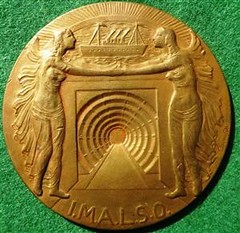
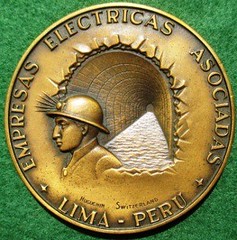
Medallions from Belgium Antwerp, Opening of the St Anna Tunnel under the River Schelde 1933, bronze medal by Pivanand Peru. Peru, Trans-Andean Water Tunnel Completed 1962, bronze medal by Huguenin
Bottom two Images kind permission of Charles Riley and taken from his website of medals for sale.
http://www.charlesriley.co.uk/MedalsUnder50.htm
MPC E-Fest (May 3, 2020)
In the May 4, 2020 MPC Gram for collectors of Military Payment Certificates and other military numismatics, editor Fred Schwan reported on the group's first online gathering, held in lieu of their cancelled 2020 MPC Fest. -Editor
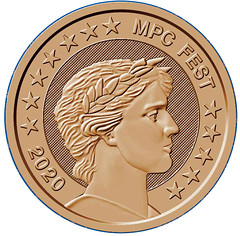 "On Sunday, 3 May, 2020, many of us enjoyed the first ever e-Fest. There were over 40 attendees, plus one very enthusiastic dog, and twelve staff briefings were given. As is usual for Fest, attendees represented many states, and
signed in from at least three countries other than the US – Denmark, Canada, and Japan. We began with a coin challenge, moment of silence to remember David Seelye and others of our comrades who are no longer with us, and introductions.
"On Sunday, 3 May, 2020, many of us enjoyed the first ever e-Fest. There were over 40 attendees, plus one very enthusiastic dog, and twelve staff briefings were given. As is usual for Fest, attendees represented many states, and
signed in from at least three countries other than the US – Denmark, Canada, and Japan. We began with a coin challenge, moment of silence to remember David Seelye and others of our comrades who are no longer with us, and introductions.
"MANY thanks to Ray Feller for organizing this and coaching us through it, with assistance from Steve Feller, and following up the brilliant suggestion of Jim Downey that this event happen. "
Fred adds:
"The 2020 medals are being manufactured in limited quantities. The silver are over subscribed, but a limited number of bronze (as shown) are available at $6 postpaid. Interested collectors can reserve one (limit 2) at $6 postpaid by writing fredschwan@yahoo.com."
High Premiums for Gold (May 3, 2020)
Len Augsburger forwarded this Bloomberg report on the high premiums being paid for retail gold. Thanks. -Editor
"Retail investors can’t seem to get enough of gold during the coronavirus crisis, and they are willing to pay staggering amounts to get their hands on it.
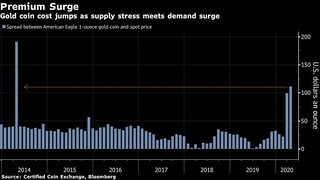 "Consumers who want to buy gold coins typically have to pay more than the per-ounce prices quoted on financial markets in London and New York. That premium has jumped to $135, more than tripling from two months ago, said Robert
Higgins, chief executive officer at Argent Asset Group LLC in Wilmington, Delaware.
"Consumers who want to buy gold coins typically have to pay more than the per-ounce prices quoted on financial markets in London and New York. That premium has jumped to $135, more than tripling from two months ago, said Robert
Higgins, chief executive officer at Argent Asset Group LLC in Wilmington, Delaware.
“There has never been a time for American Gold Eagles at this premium level,” Higgins said in an interview, referring to the popular U.S. bullion coin.
"The surge is being exacerbated by coronavirus-related lockdowns, which have led to a squeeze in the supply of coins and bars available for shipment around the globe. At the same time, bullion’s status as a haven is luring investors rattled by worldwide market and economic turmoil.
“Until the world catches up with the imbalance and gets back to a normal balance of supply and demand, the premiums will stay,” Higgins said."
To read the complete article, see:
Gold Buyers Are Forking Over Lofty $135 Premiums for U.S. Coins (https://finance.yahoo.com/news/gold-buyers-forking-over-lofty-125333131.html)
PCGS Members Only Shows Eyed (May 5, 2020)
On May 5th the Professional Coin Grading Service (PCGS) announced a series of potential “substitute” PCGS Members Only coin shows should upcoming major shows be cancelled due to coronavirus restrictions. Here's an excerpt from the press release. -Editor
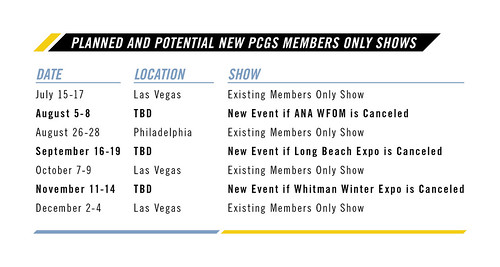
The numismatic hobby, like seemingly every other part of our lives, finds itself at a crossroads. How and when will it be safe to go back to everyday normal life? Is what we consider “normal” going to be normal at all? The world is on edge, and it’s no different in the world of numismatics. How will the events of the last few months shape numismatics for years to come? We all know there's a light at the end of the tunnel, but at this moment we simply don't know what the future holds, and our hobby is currently held hostage by the uncertainty of the ongoing crisis.
In response to this uncertainty, PCGS is announcing the potential addition of three “substitute” PCGS Members Only Shows to the 2020 numismatic show calendar in the event major numismatic trade shows are not able to occur as originally planned. If the August ANA World’s Fair of Money in Pittsburgh, the September Long Beach Expo, and/or the November Whitman Winter Expo in Baltimore are cancelled, PCGS will plan to host smaller, substitute PCGS Members Only Shows during their originally scheduled dates. These shows would likely occur in either Las Vegas, Nevada, or Southern California, depending on local and federal safety restrictions and guidelines in place at that time. Our longstanding relationships with venues in these locations puts PCGS in the unique position of hosting fit-to-scale trade shows on short notice.
Should these much smaller “substitute” shows occur, PCGS is committed to strictly following state and CDC guidelines to ensure the health and safety of all attendees. Whatever guidelines we need to follow, temperature checks at the door from a licensed professional, social distancing, greater space between tables, limited numbers of people on the bourse floor at one time – we will make it happen. We’ll build an event that safely fits within guidelines laid out by the respective venue as well as state and federal government regulations.
Last week's article on "Coronavirus coin shows" discussed the tough options facing show promoters in an era of social distancing. These smaller “substitute” shows are one option, but aren't much help to the finances of state and national clubs losing revenue to state-mandated closings. In cases where local officials will allow smaller socially-distanced gatherings the traditional show sponsor may be able to pull together an event that obviates the need for a “substitute” show elsewhere. -Editor
To read the complete press release, see:
PCGS Considers Additional Members Only Shows to Offset COVID-19 Effects
(https://www.pcgs.com/news/pcgs-considers-additional-members-only-shows-to-offset-covid-19-effects)
To read the earlier E-Sylum article, see:
CORONAVIRUS COIN SHOWS (https://www.coinbooks.org/v23/esylum_v23n18a17.html)
Slow Mail Around the World (May 5, 2020)
Howard Daniel writes:
"I got the below from www.travelnewsasia.com. There have been many complaints in the numismatic world about very slow mail. Here is the reason"
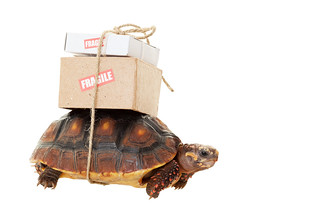 Owing to the drastic 95% reduction in passenger flights, which are typically used to transport mail, and a 25-30% increase in demand for e-commerce as customers and businesses resort to online purchasing in response to social distancing
restrictions, postal administrations face a challenge in sending and delivering international mail, in particular, cross-continental mail.
Owing to the drastic 95% reduction in passenger flights, which are typically used to transport mail, and a 25-30% increase in demand for e-commerce as customers and businesses resort to online purchasing in response to social distancing
restrictions, postal administrations face a challenge in sending and delivering international mail, in particular, cross-continental mail.
“Posts are trusted partners in the delivery of goods, vital medical supplies and essential information on the pandemic,” said UPU Director General Bishar A. Hussein. “The cancellation of more than 4.5 million passenger flights – the primary means of transporting post - has meant that capacity is scarce, costs more and takes longer. Action needs to be swiftly taken to address the shortfall in air cargo capacity and to keep the mail moving.”
Thanks. I excerpted the text and added the image. -Editor
Numismatic News: COVID Business Landscape (May 7, 2020)
Tom Michael at Numismatic News published a great article on the hobby business landscape. Check it out! -Editor

“Our office is now closed to the public, and for the last 5-6 weeks my employees have been working from home,” said Garrett. We are trying to catch up on long put-off chores – sorting coins, filing, marketing, etc. My wife and I have been coming to the office throughout to answer the phones and receive shipping.”
"Those whose primary source of supply that came from shows are experiencing the most severe downturns in business. They have strong customer demand, but do not have the coins to sell them.
"Longtime gold dealer Robert Steinberg, owner of Steinberg’s, Inc., related that, “we do 90 percent of our buying at coin shows and since all of the shows have been cancelled since the Atlanta ANA in February it’s been difficult to find new material. If we could find fresh material we could easily sell it on our website – as people have more time to check out coin dealer websites during the quarantine!”
"Steinberg is one of the best world gold coin dealers around, and shortly after hearing from him I saw that he had circulated a list of newly acquired coins for sale. Goes to show, you can’t keep a good man down!"
To read the complete article, see:
Industry Insider: COVID Business Landscape (https://www.numismaticnews.net/article/industry-insider-covid-business-landscape)
To read the earlier E-Sylum article, see:
CORONAVIRUS UPDATES: MAY 3, 2020 (https://www.coinbooks.org/v23/esylum_v23n18a16.html)
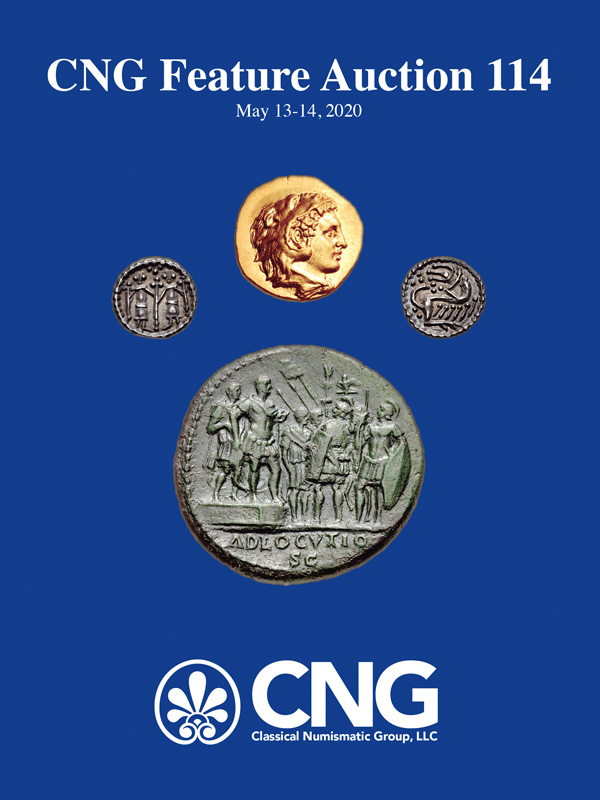
NOTES FROM E-SYLUM READERS: MAY 10, 2020
An "immensely enjoyable and highly educational periodical"
With the subject line "You win", ANA Edition reader Tom Stewart writes:
 "I began receiving The E-Sylum when I became an ANA life member. At first, I would skim the table of contents and move on. I am a bibliophile, but not particularly of numismatic books. However, as time went on, I found myself
scrolling further and further down the e-mail, enjoying the extraordinary photography and really esoteric subject matter. “Chinese Whu Zu Coin Varieties System Offered,” from this issue, for example. The exonumia, paper money and ancients are
fascinating, as are the coin vignettes and mint records (yes, I find myself even looking at these!). Now, I look forward to each issue and spend perhaps too much time on each. Thank you for a truly different, immensely enjoyable and highly
educational periodical."
"I began receiving The E-Sylum when I became an ANA life member. At first, I would skim the table of contents and move on. I am a bibliophile, but not particularly of numismatic books. However, as time went on, I found myself
scrolling further and further down the e-mail, enjoying the extraordinary photography and really esoteric subject matter. “Chinese Whu Zu Coin Varieties System Offered,” from this issue, for example. The exonumia, paper money and ancients are
fascinating, as are the coin vignettes and mint records (yes, I find myself even looking at these!). Now, I look forward to each issue and spend perhaps too much time on each. Thank you for a truly different, immensely enjoyable and highly
educational periodical."
John Esterly writes:
"I receive The E-Sylum as a Life Member of the ANA and thoroughly enjoy reading it - kudos on curating such a wide variety of numismatic articles! Thank you again for everything you do for the coin community!"
Thank you! Your notes made my day. This is why we enjoy sharing the interesting bits of numismatic information we come across each week. No matter what you collect, there's always something new to learn in numismatics, and that's what keeps it fun. -Editor
To read last week's issue, see:
Volume 23, Number 18, May 3, 2020 (https://www.coinbooks.org/v23/club_nbs_esylum_v23n18.html)
On Naming The Asylum and The E-Sylum
Joel Orosz of Kalamazoo, MI writes:
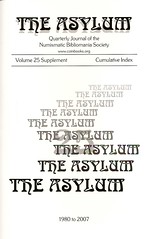 "Fun additional fact: when I was editing The Asylum, in 1987, if memory serves, Dave Bowers suggested that the journal might be renamed The Bibliophile. I put the question to the NBS membership, and the overwhelming
response was to stick with The Asylum."
"Fun additional fact: when I was editing The Asylum, in 1987, if memory serves, Dave Bowers suggested that the journal might be renamed The Bibliophile. I put the question to the NBS membership, and the overwhelming
response was to stick with The Asylum."
To read the earlier E-Sylum article, see:
NOTES FROM E-SYLUM READERS: MAY 3, 2020 : Naming The Asylum (and The E-Sylum) (https://www.coinbooks.org/v23/esylum_v23n18a22.html)
Dave Hirt on Riddell, Philadelphia Society
Dave Hirt writes:
"A few issues back in The E-Sylum there was a post on John L. Riddell, the New Orleans Mint melter. I have a book on him in my library titled A Long Ride in Texas. It was in the late 1830's and he went there to study the natural history of Texas. So, He really was a man of many talents.
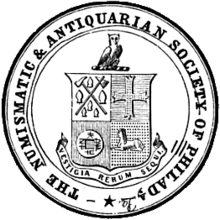 "Also I have a have question for our readers. Does The Numismatic and Antiquarian Society of Philadelphia still exist? I have a complete set of their proceedings, the last one dated 1946. However some years ago at an ANA convention in
Phila., I asked and was told that they were still active and had meetings. I have not heard one word about them in years."
"Also I have a have question for our readers. Does The Numismatic and Antiquarian Society of Philadelphia still exist? I have a complete set of their proceedings, the last one dated 1946. However some years ago at an ANA convention in
Phila., I asked and was told that they were still active and had meetings. I have not heard one word about them in years."
This question came up recently in my work with the Newman Numismatic Portal. The archives of the Numismatic and Antiquarian Society of Philadelphia are at the Historical Society of Philadelphia. We had also heard that the society had lived on somehow, but had never been able to connect with anyone who could confirm that. We reached out to the Pennsylvania Association of Numismatists (PAN), and Chairman of the Board Don Carlucci called dealer Ruth Bauer, Harry Forman's partner in Philadelphia. She's in her 90s and said the group once had their own building - I didn't know that. But their membership and finances dwindled until they finally just shut down.
The last published Proceedings of NASoP on the Newman Portal is from 1945, but the HSoP has archives through 1984. The philadelphiabuildings.org web site lists the "Numismatic & Antiquarian Society of Philadelphia Clubhouse & Museum" at "S 21ST ST near PINE ST". There's no other information about the building, when it was in use by the society, or whether it is still standing. Can any of our readers provide more information? -Editor
For the building record, see:
Numismatic & Antiquarian Society of Philadelphia Clubhouse & Museum (https://www.philadelphiabuildings.org/pab/app/pj_display.cfm/16463)
To read the Proceedings on NNP, see:
Proceedings of the Numismatic and Antiquarian Society of Philadelphia
(https://nnp.wustl.edu/library/publisherdetail/512040?Year=1946&displayAmt=50)
To read the earlier E-Sylum articles, see:
NUMISMATIC AND ANTIQUARIAN SOCIETY OF PHILADELPHIA ARCHIVES (https://www.coinbooks.org/esylum_v18n52a13.html)
DR. RIDDELL: THE MELTER AND THE PLAGUES (https://www.coinbooks.org/v23/esylum_v23n15a26.html)
Smearing Blue Ink Security Feature
Bob Bednar of Naples, Florida writes:
"I always like reading your informative publication. Nice that you’re in touch with experts like Bob Leuver. In the early 90’s I supplied American Express Traveler Cheque paper to United States Bank Note. I recall a security feature, blue ink that smeared when moistened, on the back side of the note. But Bob’s correct that this new ink is cool."
To read the earlier E-Sylum article, see:
BLEEDING INK SECURITY FEATURE (https://www.coinbooks.org/v23/esylum_v23n18a30.html)
More on the Wyoming Post Trader Token Hoard
Dave Schenkman writes:
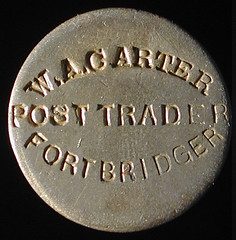 "Reading The E-Sylum reminded me that in 1971 Joe Levine and I purchased a hoard of more than two hundred post trader tokens from Fort Bridger and Camp Brown, Wyoming from book dealer Frank Katen. He claimed that he sold us the
entire group, but every time I would stop by his shop a couple more would be in his token books. Later John Ford told me he had purchased “the other half” of Katen’s tokens. I included ours on one of my fixed price lists, at $30-$35 each (there were
six varieties, as I recall) and sold them all."
"Reading The E-Sylum reminded me that in 1971 Joe Levine and I purchased a hoard of more than two hundred post trader tokens from Fort Bridger and Camp Brown, Wyoming from book dealer Frank Katen. He claimed that he sold us the
entire group, but every time I would stop by his shop a couple more would be in his token books. Later John Ford told me he had purchased “the other half” of Katen’s tokens. I included ours on one of my fixed price lists, at $30-$35 each (there were
six varieties, as I recall) and sold them all."
Thanks for the background. For researchers, Dave's old Fixed Price Lists are available on the Newman Numismatic Portal. -Editor
To read the Fixed Price Lists, see:
David E. Schenkman [Fixed Price List] (https://nnp.wustl.edu/library/publisherdetail/518264)
To read the earlier E-Sylum article, see:
MORE ON THE FORT BRIDGER WYOMING TOKENS (https://www.coinbooks.org/v23/esylum_v23n18a23.html)
More on the First Non-Royal on British Coinage
David Powell writes:
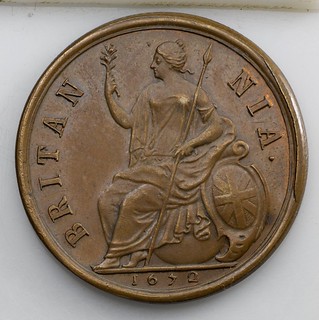 "It could be argued that maybe Frances, Duchess of Richmond, one of Charles II’s mistresses, has the honour of being the first non-royal depicted; some sources state that she was the model for Britannia when the latter was introduced
onto the regal coinage in 1672 {with patterns back to 1665}.
"It could be argued that maybe Frances, Duchess of Richmond, one of Charles II’s mistresses, has the honour of being the first non-royal depicted; some sources state that she was the model for Britannia when the latter was introduced
onto the regal coinage in 1672 {with patterns back to 1665}.
"Depictions apart, what about the first non-royal to have his/her surname on a British coin? Any advance on Robert de Hadelie, one of Edward I’s moneyers at Bury St.Edmunds in the 1280s? As surnames were largely a 13th/14th century innovation, that probably isn’t too easy to beat."
Interesting topic! Thanks. -Editor
Image from:
Coin Collectors Blog : The Allegory of Liberty (http://coinsblog.ws/2017/01/the-allegory-of-liberty.html)
To read the earlier E-Sylum article, see:
NOTES FROM E-SYLUM READERS: MAY 3, 2020 : St. George First Non-Royal on British Coinage (https://coinbooks.org/v23/esylum_v23n18a22.html)
Asylum Back Issues Sought
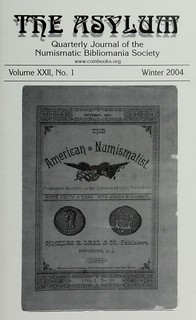
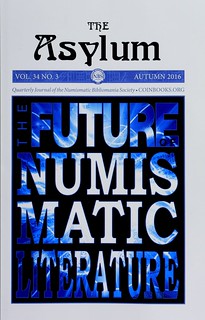
WANTED: Winter 2004 and Fall 2016 Asylum issues
Darryl Atchison writes:
"As part of reorganizing my library during the Covid crisis, I noticed that I was missing a number of issues of The Asylum. Fortunately, Maria Fanning was able to help me out with most of them but there were two issues that the NBS didn't have back copies of: Vol. 22, no. 1 and Vol. 34, no. 3.
"Again, I want to implore our wonderful readers if one has a duplicate or unwanted copy of either of those issues to please let me know at atchisondf@gmail.com as I would hate not to have a complete set."
Franklin & Washington
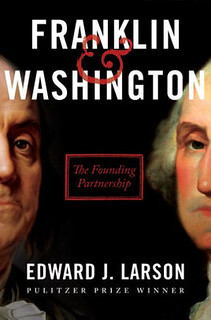 Patrick "Ben Franklin" McBride writes:
Patrick "Ben Franklin" McBride writes:
"It was a delightful surprise to see your inclusion of the Franklin & Washington book by Larson in The E-Sylum. I am just finishing it now and can’t wait to read it again as I often do with any Franklin material I encounter.
"This is a wonderful book and brings home the very unique relationship that these two pillars of our republic had with each other.
To read the earlier E-Sylum article, see:
LOOSE CHANGE: MAY 3, 2020 : Portraits of Franklin & Washington (https://www.coinbooks.org/v23/esylum_v23n18a32.html)
On Storing and Finding Books
David Powell adds:
"Books look best on the shelves stored by size. If you put items with similar page size together, not only do they look good that way, it also stops the big ones falling over on to the little ones, which keeps everything upright and avoids putting strain on the binding. I hate seeing a book where the pages, when stood upright, are slanting in one direction because the book has been stored leaning over. Also, storing by size stops little books getting squeezed out of sight to the back.
On the other hand, practicality says that you should store by subject so that you can find everything easily. Great, but it doesn’t sit hand in hand with the above.
I personally get round the issue by keeping a large Excel spreadsheet with all my books on, listing:
- Subject area and sub-division
- Author
- Title
- Bookcase no.
- Shelf no.
- Language {not absolutely necessary, as it should be obvious from the title}
That usually works provided I have my computer on, but you still have to maintain the list and find the book on 32” of shelf. Plus, if you forget to record a new book or the movements of an old one…..
Any other suggestions as to how best to overcome the problem of subject v size?"
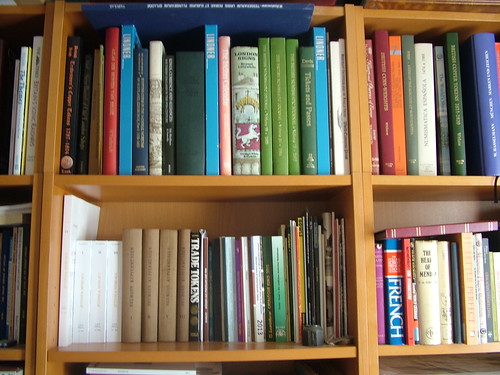
Some of David's shelves
What do readers think? There are probably as many ways to do this as there are numismatic libraries. What works for you? -Editor
To read the earlier E-Sylum article, see:
FINALLY THERE'S TIME FOR YOUR BOOKS (https://coinbooks.org/v23/esylum_v23n18a33.html)
U.S. Mint Mahogany Finish Process
Craig Sholley writes:
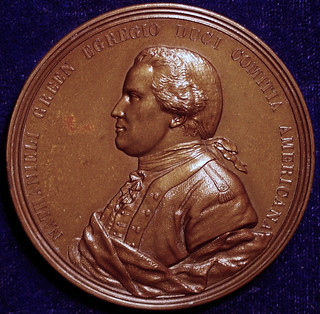 "I read Dick Johnson’s article on “Mahogany Finish” in the May 3rd issue of The E-Sylum and though I usually concur with Dick’s definitions, this time I must disagree. while the historical record does show that the British mint
used fire-bronzing until the early 1800’s, there is no evidence that the US Mint ever used that process.
"I read Dick Johnson’s article on “Mahogany Finish” in the May 3rd issue of The E-Sylum and though I usually concur with Dick’s definitions, this time I must disagree. while the historical record does show that the British mint
used fire-bronzing until the early 1800’s, there is no evidence that the US Mint ever used that process.
"Rather, the records show that US Mint used various formulations of acidic bronzing solutions to chemically bronze medals and coins. With the return of Franklin Peale from his visits to European mints, the US Mint copied the French bronzing formula and used that from June of 1835 until they switched to the use of yellow brass and highlighting solutions for that alloy.
"For those interested in the processes used at the US Mint, a couple years ago I published an article based on the historical records, “19th Century Medal-Making Processes,” in the MCA Advisory."
Thank you. Interesting history. -Editor
To read the earlier E-Sylum article, see:
VOCABULARY TERM: MAHOGANY FINISH (https://coinbooks.org/v23/esylum_v23n18a24.html)
Query: Plymouth Quadricentennial Medal?
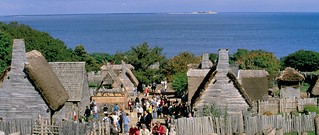 Anne E. Bentley of the Massachusetts Historical Society writes:
Anne E. Bentley of the Massachusetts Historical Society writes:
"Does anyone in the readership know if a medal or commemorative coin is in the works to celebrate Plymouth Mass. 400th anniversary this year?"
Good question - has anyone heard of one? -Editor
Happy V E Day
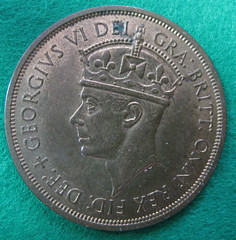
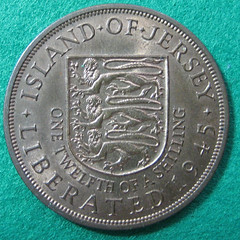
Images courtesy of Graham Kirby
David Pickup writes:
"These are two links to topical sites for VE Day."
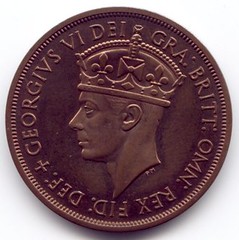
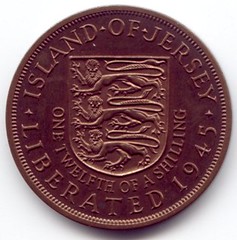
A commemorative issue which owes its existence to Mr. J. Wilfrid du Pre of the Societe Jersiaise. The coins were first minted in 1949 and commemorate the Liberation of the Island from the German Occupation of the 8th of May 1945. They were released into circulation on the 8th of May 1949. This issue was minted in 1949, 1950, and 1952.
When India became independent in 1947, the King gave up his title of Emperor of India (IND. IMP) and this title were removed from coins.
To read the complete article, see:
One Twelfth of a Shilling - King George VI Liberation Commemorative (http://jerseycoins.com/pen12/12_45.htm)
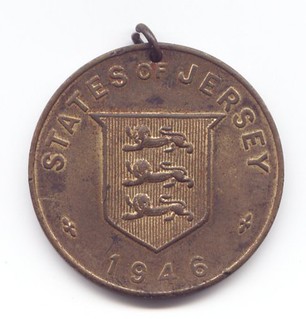
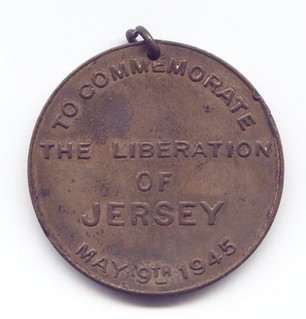
To read the complete article, see:
Jersey Liberation Medal (http://jerseycoins.com/medal/Medal.htm)
Thanks! -Editor
For more information on V E Day, see:
Victory in Europe Day (https://en.wikipedia.org/wiki/Victory_in_Europe_Day)
How Do I Spell Thee? Let me Count the Ways...
Dave Bowers writes:
"A burden that all coin collectors have had to bear is the word “numismatic,” which is seemingly incomprehensible to the general public. In the June 1938 issue of The Numismatist ANA librarian W.S. Dewey submitted a list of misspellings of the word which had come to his attention through mail addressed to the association. Included were the following: numatic, numisatic, nunisatic, munismatic, numesmatic, pneumatic, numismaitic, numisitic, numasmatic, numismutic, nunisnatic, numimatic, nomismatic, newmismatic, amunistac, numusmatic, nuismatic, numastic, numerismatic, numistic, numistatical, numismastic, numismatical, and nunismetic."
Dennis Tucker adds:
"Here’s another hobby-related misspelling. This is nowhere near “numismatic” in breadth or depth, but an interesting typo I’ve seen many times over the years is commerative coin instead of commemorative coin. I’ve seen it in hastily dashed-off notes, letters, and emails, but also in print! It’s as if a writer gets tired halfway through the word and unconsciously abbreviates it.
If you Google “commemorative coin” you get 2,640,000 results. But if you Google “commerative coin” you get 70,200 results—not too shabby at about 3% of the correct spelling—mostly on Pinterest, eBay, and Amazon, but also in the Navy SEAL Museum gift shop, the BBC, a U.S. Senate press release, Getty Images, and even various numismatic web sites! A quick search of the Newman Numismatic Portal shows the misspelling in almost 200 places—in auction catalogs, club newsletters, books, and nearly every major hobby publication."
And the list goes on, I'm sure. -Editor

URAM AND TUCKER REAPPOINTED TO CCAC POSITIONS
Coin Update published an article on the U.S. Mint's reappointment of Tom Uram and Dennis Tucker to positions on the Citizens Coinage Advisory Committee (CCAC). With permission we're republishing this here. -Editor
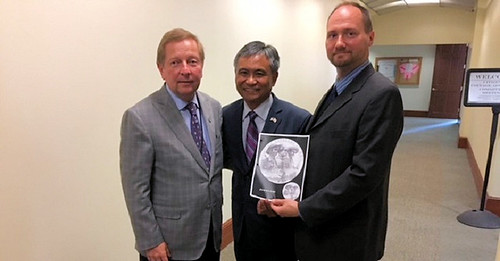
CCAC members Tom Uram and Dennis Tucker with General Tony Taguba (middle) and the design of the Filipino Veterans of World War II Congressional Gold Medal, June 2017. (Photo by Richard Jewell).
The United States Mint hosted a virtual meeting of the Citizens Coinage Advisory Committee on Tuesday, March 10, 2020. The CCAC typically gathers in person at Mint headquarters on Ninth Street in Washington, D.C., but the committee’s March 2020 meeting was held by telephone out of an abundance of caution surrounding the novel coronavirus pandemic. All 11 members were in attendance, phoning in from around the country and overseas.
The CCAC is a congressionally created public committee that advises the Secretary of the Treasury on themes and designs of circulating coinage, bullion coins, Congressional Gold Medals, national medals, and commemorative coins.
In the administrative portion of the committee’s March 2020 meeting, U.S. Mint Director David J. Ryder announced the continuing service of Thomas Uram as CCAC chairman. Uram, well known in the hobby community as president of the Pennsylvania Association of Numismatists and a past governor of the American Numismatic Association, was first appointed to the chair in December 2018. His second one-year term as chair comes in his second four-year term as a member of the committee. Director Ryder praised Uram’s service as chairman over the course of 2019 and into the first quarter of 2020. Uram, a professional financial representative, has chaired the committee in its discussions of the American Platinum Eagle Proof coins, the American Innovation dollar program, several Congressional Gold Medals, and commemorative coins including those of the Basketball Hall of Fame and the Women’s Suffrage Centennial, among others.
In addition to Uram’s continuing chairmanship, Director Ryder announced Dennis Tucker’s appointment to a second term as the committee’s Specialist in Numismatics. “I appreciate the work you’ve done,” Ryder told Tucker. “I personally spoke to the Secretary of the Treasury about what a great asset you are to the committee, and he wholeheartedly renominated you.” Tucker is known to the hobby as the publisher of Whitman Publishing and a frequent speaker at the ANA World’s Fair of Money. In 2016 he authored the award-winning American Gold and Silver: U.S. Mint Collector and Investor Coins and Medals, Bicentennial to Date. In the publishing arena, he specializes in books on numismatics, banking, and financial history, the American presidency, U.S. political and military history, and other non-fiction topics.
Other members of the 11-person Citizens Coinage Advisory Committee include physician and medical professor Dr. Lawrence Brown, studio artist and past president of the American Medallic Sculpture Association Jeanne Stevens-Sollman, and CPA and transportation logistics expert Sam Gill (each a Representative of the General Public); businessman and numismatic historian Mike Moran (recommended by the Senate Minority Leader); attorney and medallic-art historian Donald Scarinci (recommended by the Senate Majority Leader); numismatic editor and ancient-coin expert Mary Lannin (immediate past chair, recommended by the House Minority Leader); history professor and lecturer Dr. Dean Kotlowski (Specialist in American History); Vice President of Art and Historical Collections and Curator of Sculpture at Brookgreen Gardens, Robin Salmon (Specialist in Sculpture or Medallic Arts); and American Numismatic Society Curator Emeritus and former Curator of the American Numismatic Association, Robert Hoge (Specialist in Numismatic Curatorship).
The CCAC is a great group of folks who have to make a lot of tough and important decisions on designs for new U.S. coins and medals. A difficult but rewarding job with lasting consequences. Thanks for all who have served, and congratulations and good luck to Tom and Dennis on their new terms. -Editor
To read the complete article, see:
Uram continuing as Chairman and Tucker as Numismatic Specialist on the Citizens Coinage Advisory Committee
(http://news.coinupdate.com/thomas-uram-and-dennis-tucker-renominated-on-the-citizens-coinage-advisory-committee/)
To visit the Citizens Coinage Advisory Committee, see:
https://www.ccac.gov/
VOCABULARY TERM: MAKER’S MARK
Dick Johnson submitted this entry from his Encyclopedia of Coin and Medal Terminology. Thanks. -Editor
Maker’s Mark. A name, monogram, signature, symbol or other identifying mark
to identify the artist or manufacturer who created a particular piece. While the forms of maker’s marks are varied, the location is fairly standard – lower portions near rims or edges. Some parts of hallmarking are maker’s marks, as well as name punches, edge lettering, mintmarks, disks and such. Artists have signed their works for centuries – a name in full, initials, or an identifying symbol. Manufacturers, striker, caster, foundry, mints, all may have logos, symbols or letters placed on their products. See disk; monogram; signature; mintmark; hallmark and hallmarking; touch, touchmark; edge lettering; punch, pencheon (1).
Reference:
NE42 {1982} Doty, p 204-205.
Looking for the meaning of a numismatic word, or the description of a term? Try the Newman Numismatic Portal's Numismatic Dictionary at: https://nnp.wustl.edu/library/dictionary
Or if you would like a printed copy of the complete Encyclopedia, it is available. There are 1,854 terms, on 678 pages, in The Encyclopedia of Coin and Medal Technology. Even running two a week would require more than 19 years to publish them all. If you would like an advance draft of this vital reference work it may be obtained from the author for your check of $50 sent postpaid. Dick Johnson, 139 Thompson Drive, Torrington, CT 06790.
EDWARD H. FISH
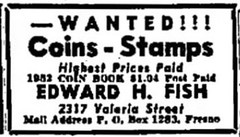 Edward H. Fish - In 1945, he and his wife ran Ed-Ann Hobby Shops, Babbitt Building, Valencia, Buckeye, Arizona.
Edward H. Fish - In 1945, he and his wife ran Ed-Ann Hobby Shops, Babbitt Building, Valencia, Buckeye, Arizona.
In 1945, Edward H. Fish was ANA Member No. 11214, Buckeye, Arizona.
In 1948 he was president of the Fresno Stamp Club, and conducted the stamp auction at the California Hotel.
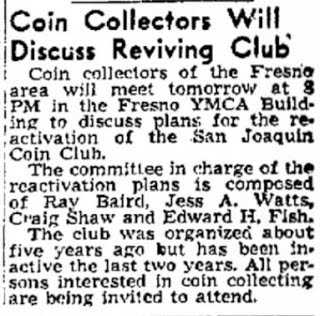 On Monday February 18, 1952, Fresno area coin collectors met at the YMCA to discuss reviving the San Joaquin Coin Club. Edward H. Fish was one of four committee members for the "Reactivation Plan".
On Monday February 18, 1952, Fresno area coin collectors met at the YMCA to discuss reviving the San Joaquin Coin Club. Edward H. Fish was one of four committee members for the "Reactivation Plan".
Edward H. Fish lived nearby at Buena Park close to his shop in Knotts Berry Farm, Ghost Town, California, where he kept shop in the Miner's Bank. The Bank still stands today and is part of an amusement park begun by Walter Knott on his berry farm. The Miner's Bank was built in 1954, merely as a replica of an Old West Gold Rush Era type bank. It was solely occupied by Ed Fish as his coin and stamp shop. The park is located a few miles west of Anaheim, California.
He is buried in Coquille Masonic Cemetery.
To read the complete article, see:
FISH, EDWARD H. (http://www.numismaticmall.com/numismaticmall-com/fish-edward-h)

HARVEY STACK'S NUMISMATIC FAMILY, PART 69
The latest article in Harvey Stack's blog series is about the firm's landmark auction sales of 1976. Thanks, Harvey. -Editor
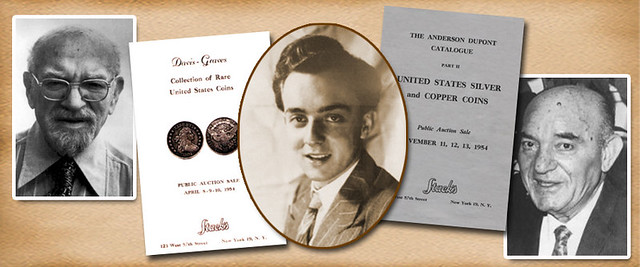
Stack's auction program for 1976 was very exciting, for not only did we have the contract to present the official auction at the ANA’s annual convention in the summer, but we offered seven other major sales as well. Four were before the ANA sale and three came after. In order to get all this work done and continue our normal coin business in the shop and on the road, many evenings and weekends were required of us.
We began the year in February with the famous TAD Collection of United States Large Cents, an outstanding offering of dates and varieties in high grades, from 1793 to 1857. There was also a comprehensive collection of other U.S. coins from the half cent to the $20 gold, a collection that has been mentioned in later pedigrees by many catalogers since it was sold.
In March we offered coins from the John Work Garrett Collection and the Johns Hopkins University library, a selection of items sold to provide funds for the expansion of the library. Some popular rarities and high quality duplicates graced the catalog. The sale realized record prices and there was impressive attendance at the auction. It was a great beginning for 1976.
In April our catalog featured important consignments of United States gold, silver and copper coins that attracted many bidders. May brought the famous Laird Park Collection of U.S. colonial coins. Besides containing many rare and choice pieces pedigreed to some of our earlier sales, it was highlighted by a Birch cent, four different Continental dollars, (including one in brass), a Washington Born Virginia in silver, and many specimens of the various colonies. The sale also contained many type coins, and Mint State and Proof examples of most series. It was an important sale that appealed to specialists as well as more general collectors.
Next came our official auction for the American Numismatic Association Convention in August. It was a large sale, over 4,100 lots, and exceeded the size of most previous ANA auctions, as well as being one of the most comprehensive offerings sold in that venue in decades. Featured were coins from the Massachusetts Historical Society, and the Boston Museum of Fine Arts, sold to enhance their display facilities. Both had coins from the famous Adams family of colonial days, including some of the finest known colonial coins and a magnificent offering of U.S. large cents, with many varieties and finest known. There was also a collection of half cents as well as coins of all denominations from small cents to double eagles.
There were Proof year sets of cents to the dollar from 1858 to 1915, plus outstanding United States paper money and an offering of over 140 U.S. patterns. Among world coins there were extensive collections of Greek and Roman coins plus outstanding gold and silver coins of the world. There were six sessions in the auction, each of which was well attended and saw strong bidding. Many records were set and the results were superb.
In the last quarter of 1976 Stack’s held a public auction each month, beginning in October when we sold the William H. Fenn Collection of United States Gold, Silver and Copper coins. November featured a combination of two old-time collections that complemented each other: the estates of Marion E. Emrick and Harold F. Coffey. This sale of 1,627 lots offered comprehensive collections of United States gold, silver and copper coins. In December we offered further items from the Emrick and Coffey collections, this time enhanced with the Lloyd Cabot Briggs collection of ancient and world gold, silver and copper coins. This provided our clients with a wonderful array of coins to bid on and was a great conclusion to Stack’s incredible 1976 auction season.
To read the complete article, see:
Harvey Stack Remembers: Growing up in a Numismatic Family, Part 69
(https://www.stacksbowers.com/News/Pages/Blogs.aspx?ArticleID=Harvey-Stack-Remembers-Part-69)
To read the earlier E-Sylum article, see:
HARVEY STACK'S NUMISMATIC FAMILY, PART 68 (https://www.coinbooks.org/v23/esylum_v23n17a15.html)
MORE ON EDDIE ‘J.J. TEAPARTY’ LEVENTHAL
Denis Loring writes:
"The article on Ed Leventhal's passing brought back fond memories for me as well. J. J. Teaparty was my numismatic hangout of choice during my college years and thereafter. I spent many happy hours there. Sometimes when the store was busy, Ed would let me go behind the counter and help serve the customers. In return, he would let me upgrade my Whitman folder sets from his more than ample stock (often 20-30 pieces, AG to the occasional XF, kept in plastic tubes) of circ better dates, things like 1911-D cents and 1926-S dimes. I also became close friends with Mike Berton, Ed's brother-in-law who was my age and worked for JJT. Rest in peace, gentleman Ed."
Richard Lobel of Coincraft submitted these thoughts on the late Eddie Leventhal of JJ Teaparty. Thanks! Thanks also to David Sundman for passing along last week's article (linked below). -Editor
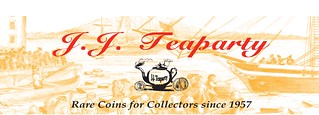 I first met Eddie Leventhal in 1963, when he opened a tiny coin shop on Bromfield Street in Boston, Massachusetts. It was so small that maybe two people could stand on either side of the counter shoulder to shoulder. There was a mezzanine,
but you had to climb a rickety ladder to get up it.
I first met Eddie Leventhal in 1963, when he opened a tiny coin shop on Bromfield Street in Boston, Massachusetts. It was so small that maybe two people could stand on either side of the counter shoulder to shoulder. There was a mezzanine,
but you had to climb a rickety ladder to get up it.
Eddie had had a nightmare one night about the 1773 Boston Tea Party, when the American colonists dumped tea in Boston Harbour and that is how he came up with the name ‘J.J. Teaparty.’ He had been managing a roller rink that his Father owned and doing coins part time. He decided to go into coins full and Bromfield Street was the hub of coin collecting in Boston at that time. I had dropped out of University for the first time and would haunt the coin shops in Boston on my lunch hour and that is how I met him. The Lipson family both Father and son had shops on Bromfield Street and were not too happy with Eddie moving in. But in the end, business is business and they all got along.
I met Ed’s Brother-in-law Mike Berton at the same time, Mike’s and my friendship has lasted almost 60 years, I speak to him at least twice a week. Mike or rather Teaparty have handled my America business for over 50 years and the sale of any important American coins we buy in Britain. Two years ago they got us $85,000 for an American coin which I thought was worth just $9,000.
Eddie was a good businessman and the company and the store grew rapidly. Teaparty became the largest of the many coin dealers in Boston. Years ago he sold the business and retired to Florida. I saw him several times in his retirement, when he was visiting Mike. Eddie was a tough old boot, but a good businessman who sure knew when to retire. He is survived by his wife Judy and two sons. He whipped up interest in coin collecting in Boston and will be remembered by us old timers.
Richard Lobel, founder Coincraft, London, England
To read the earlier E-Sylum article, see:
EDWIN LEVENTHAL (1930-2020) (https://www.coinbooks.org/v23/esylum_v23n18a11.html)
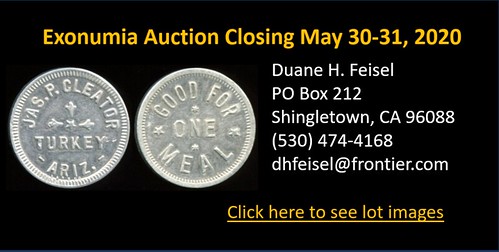
ANS MONEY TALKS: U.S. CIRCULATING COUNTERFEITS
Another American Numismatic Society Money Talks video conference has been scheduled. NOTE: these are open to members only. Great time to join! This is a fascinating topic. -Editor
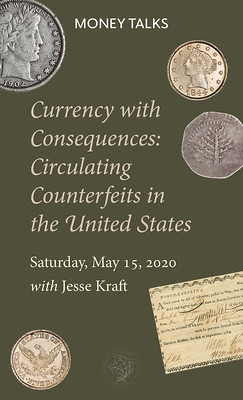 Money Talks
Money Talks
Currency with Consequences: Circulating Counterfeits in the United States
With Jesse Kraft
Saturday, May 16
1:00 pm EST
This Money Talks will be held live via video conference. As with any Money Talks, you will be able to ask questions and hear responses in real time. The session is open to ANS members only. RSVP to Emma Pratte at membership@numismatics.org to get the link.
Counterfeit money has circulated in the United States for more than 350 years. From 17th-century Massachusetts silver to 20th-century Jefferson nickels and present-day paper currency, virtually no type of money has escaped the scruples of a counterfeiter. Many have gone to great lengths to replicate genuine coins in order to successfully pass their pieces to unsuspecting victims.
Some counterfeit coins and currency circulated for years before the truth came to light. At the same time, a coterie of vigilantes were always on the lookout for fake money, and seemingly longed to bring an end to a small-time forger or a large counterfeiting ring. Join Dr. Jesse Kraft to discuss the various methods that counterfeiters used to deceive, follies that led to their demise, and the punishments that they ultimately received.
Money Talks: Numismatic Conversations is supported by an ANS endowment fund generously given in honor of Mr. Vladimir Clain-Stefanelli and Mrs. Elvira Clain-Stefanelli.
To read the complete article, see:
Money Talks: Currency with Consequences (http://numismatics.org/2005-mt/)
To read the earlier E-Sylum article, see:
ANS MONEY TALKS: BEFORE THE COINAGE ACT OF 1857 (https://www.coinbooks.org/v23/esylum_v23n09a17.html)
NUMISMATIC NUGGETS: MAY 10, 2020
It's been a while since I've been able to find time for a Nuggets column. Here's a selection of interesting or unusual items I came across in the marketplace recently. Tell us what you think of some of these. We always focus on history rather than grade, but we'll start off with some eye candy. -Editor
Finest Graded 1862 Indian Cent
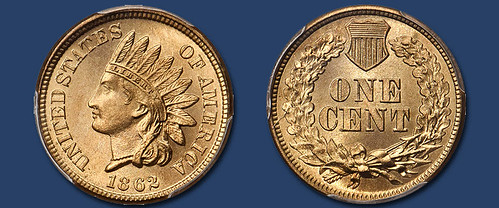
Featured in our upcoming June 2020 Santa Ana Auction is an incredible MS-68 (PCGS) 1862 Indian cent that stands alone at the top of the condition census. It is the sole finest 1862 cent graded by PCGS or NGC, and is tied with the very finest known across the entire Indian cent series. It is an ideal candidate for a high-end PCGS Registry Set of Indian cents or 19th century type coins. It simply cannot be improved upon.
With 28,075,000 pieces struck, the 1862 Indian cent has the second highest mintage of the copper-nickel, Oak Wreath series produced from 1861 through 1864. Examples of the 1862 are readily available in most Mint State grades up through MS-65, but it becomes exponentially more elusive approaching Superb Gem condition.
From the June 2020 Stack's Bowers sale. -Editor
To read the complete lot description, see:
The Single Finest Graded 1862 Cent to be Featured in our June 2020 Santa Ana Auction
(https://www.stacksbowers.com/News/Pages/Blogs.aspx?ArticleID=Single-Finest-Graded-1862-Cent-June-Auction)
1936 Toned Proof Buffalo Nickel
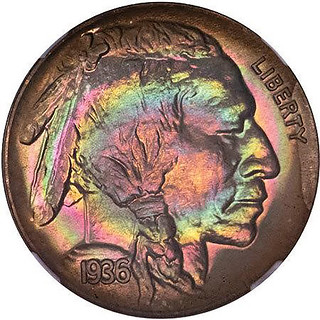
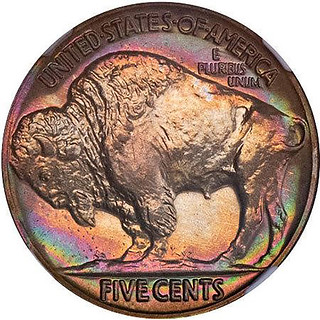
$14,000
Incredible color for Proof Buffalo Nickel. Album toning over a long period of time likely created this beauty. Previously Legend Auction 5/19 @ 12,925.
This one stopped me in my tracks when I saw it in the April 16, 2020 In the Loupe email from Harry Laibstain Rare Coins. Sorry, it's been sold. -Editor
1823/2 Quarter
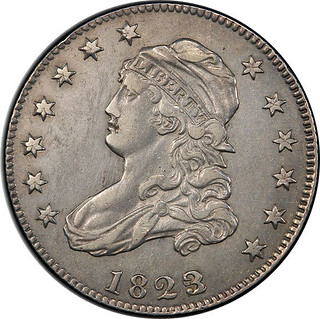
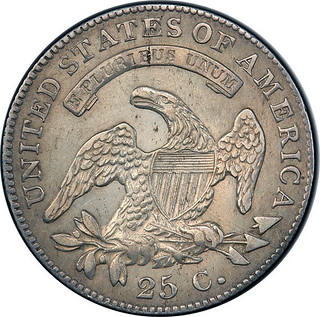
$145,000
Iconic rarity among U.S. Quarter Dollars. Seldom offered on any list. Make us an offer or propose a trade.
Another notable coin from the same Harry Laibstain Rare Coins email price list. After publishing last week's issue I saw this comment in the JR Newsletter from the John Reich Collectors Society. -Editor
Nathan Markowitz wrote:
"For provenance geeks some real news. While perusing an email from HLRC I noted an example of the rare 1823/2 quarter that I did not recognize. After consulting the excellent image gallery in the book by Rea, Peterson, Karoleff, and Kovach the “new” example was indeed the coin plated in the 1925 Browning reference. We have been looking for this XF example! It last appeared 85 years ago in 1935 on the Louis Hemmer premium list. From the Great Depression to the great pandemic its whereabouts have been shrouded in mystery. If anyone can fill in the missing provenance that would be great! "
Nice catch. Harry Laibstain adds:
"I did not know of the pedigree until Nathan came up with it. The owner has since decided to have me sell it in auction for him. It was placed in the Stack’s Bowers June sale where I’m sure they will give it a good write up based on this new information. I suspect there will be some real interest."
We'll be on the lookout for the lot description. Thanks, everyone. -Editor
To visit the HLRC web site, see:
http://hlrc.com/
Vote the Land Free
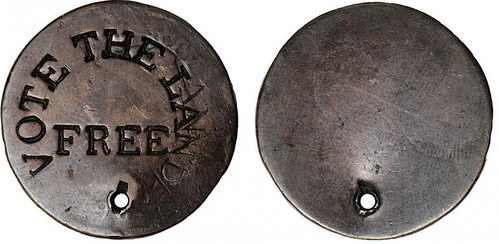
Lot 483. Foreign Coins and Tokens, USA, Hard Times Tokens, Land Limitation Scheme, VOTE THE LAND/FREE, stamped on very worn large cent, 179(6?), attributed to the National Reform Association, a political movement associated with the 1848 Presidential election, pierced, counterstamp fine; and a silver-coloured medallet, HIS GRACE MOST REV. P. J. RYAN SILVER JUBILEE, about extremely fine (2)
The slogan ‘Vote the Land Free’ was the campaign cry of the anti-slavery movement in the Presidential election. See an article by Gregory G. Brunk at www.coinbooks.org/esylum_v15n44a12.html.
Howard Daniel passed along this lot from Baldwin's of St. James. Nice to see the reference to The E-Sylum. -Editor
To read the complete lot description, see:
Lot 483. Foreign Coins and Tokens, USA, Hard Times Tokens, Land Limitation Scheme, VOTE THE LAND/FREE (https://www.sixbid.com/en/baldwins-of-st-james/7373/foreign-coins-and-tokens/
6028657/foreign-coins-and-tokens-usa?term&%3BorderCol
=lot_number&%3BorderDirection=asc&%3BpriceFrom&%3BdisplayMode
=large&%3BauctionSessions=7717%7C259467)
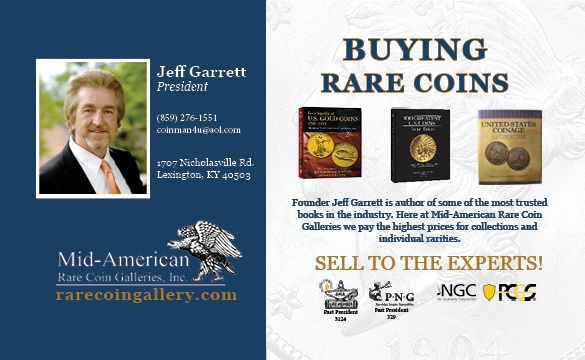
THE COINS TELL THEIR STORY BEST
In the April 2020 issue of Penny-Wise, the official publication of the Early American Coppers club (EAC), Bill Eckberg published an article titled "The Coins Tell Their Story Best". With permission, here's an excerpt. -Editor
How do we do research into old coins? In general, we look at the artifacts left behind by history – in this case by the mints – with a critical eye as a way to understand what went on: the who, what, where, when and how of the coins we love and collect. There are many sources of information that can be useful in this research. They are broadly considered primary and secondary sources. Primary sources are closest to the origin and so are considered the most reliable sources of information
Secondary sources
Most of the information we get about coins comes from secondary sources. These include books (e.g., The Red Book, Sheldon, Wright, Newcomb, Cohen, Breen, etc.), articles in journals and magazines and on the internet. These are useful, but they
always reflect the biases – even if unintentional – of the writers, so we need to take them with a grain of salt. It is also often difficult to figure out where the ideas presented as fact originated, especially as many, if not most, numismatic
researchers of the past did not cite their sources and often just repeated older (mis)information. Secondary sources with copious references are far more reliable, because at least we can figure out where to turn for corroboration and correction,
but at best all secondary sources remain subject to inadvertent copying errors and the like.
Though it may seem counterintuitive, official government reports, such as the annual reports of directors of the Mint, are also secondary sources. They are summaries of what happened. But mints are both factories and government bureaucracies, and official reports are frequently written in such a way as to promote the point of view that the writer wants to present. The information in such reports is not necessarily wrong, just not necessarily the whole truth; it is often possible to shade a technical truth to give a very false impression. It’s what we, today, call “spin doctoring.” An interesting example of this would be Robert Scot’s letter to Congress describing the creation of cent dies. One might think it a primary source, since Scot was the man who made the dies, but his description of how he claimed to do it does not square with the evidence from the coins themselves, as we shall see.
Secondary sources can still be quite useful, but it is very important to keep a healthy skepticism about everything we read in such sources.
Primary sources
There are several general types of primary sources. The first would be physical artifacts from the mint, especially coins.
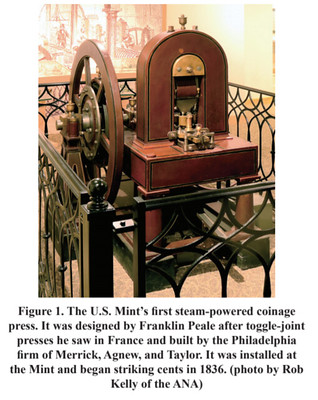 As an example of a second kind of mint artifact, the first steam-operated coinage press that the U.S. Mint owned still exists and can be seen at the American Numismatic Association’s Edward C. Rochette Money Museum. We can examine it and,
with some engineering knowhow, deconstruct how it worked. The Mint saved its galvanos and some master dies beginning around 1860, so we have physical evidence of how the coins were made after that time. However, we have almost no surviving presses,
dies, hubs or master dies from the early days of the U.S. Mint, when our early coppers were produced, so that’s not an option for us.
As an example of a second kind of mint artifact, the first steam-operated coinage press that the U.S. Mint owned still exists and can be seen at the American Numismatic Association’s Edward C. Rochette Money Museum. We can examine it and,
with some engineering knowhow, deconstruct how it worked. The Mint saved its galvanos and some master dies beginning around 1860, so we have physical evidence of how the coins were made after that time. However, we have almost no surviving presses,
dies, hubs or master dies from the early days of the U.S. Mint, when our early coppers were produced, so that’s not an option for us.
A third kind of primary source would include internal documents recording the movement of materials within the mint. It was essential that the Treasurer, Assayer/Refiner and Chief Coiner keep careful records of the movement of gold, silver and copper between them. Each was responsible to account for all of the metal that he received, and he had strict rules about what he was allowed to do with it and how and when to do it. That is why each officer with a responsibility for coinage metals had to post a bond equal to several years’ salary before he could handle gold or silver.
The coins are the most reliable primary sources. They can’t lie or shade the truth about themselves; they can only stand as mute relics of their time. If we study them, we can learn much about what they were made of, how they were made, etc. One way to do this is to compare different coins’ many physical characteristics. That can sometimes identify if the planchets were from a common source or not. Another is to compare the products of different dies. Recent digital imaging technologies have made this a far easier and more precise way to study coins. For example, digital overlays showed how Henry Voigt used templates to lay out the reverses of the Chain cents.
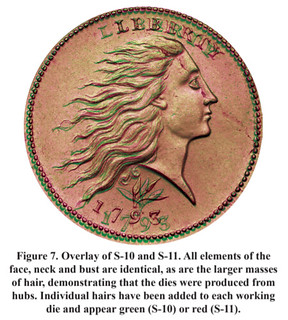
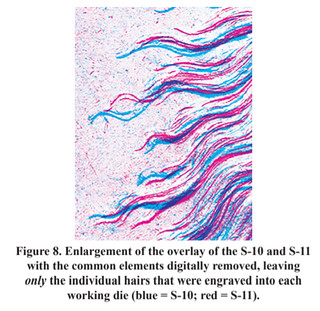
Coins can tell us more than any other source about how they were made. Though previous authors had supposed that each Wreath and 1793 half cent obverse working die was individually hand-engraved, in fact, all were produced from hubs. The illustrated overlay of the Sheldon-10 and -11 varieties, coined at least ten weeks apart, shows conclusively that the dies were created from the same hub, and that the hub contained the entire face, neck, bust and main masses of hair. The hair received additional engraving in each working die. Figure 8 shows the hair of the two coins with the common features removed, leaving only the individual hairs that are unique to each die. Similar overlays showed that not only were the two 1793 half cent obverses produced from the same hub, but that same hub had actually been created in 1792 for the obverse of the disme pattern!
I'm proud of my numismatic library. Some 3,000 volumes, all close at hand, holding scads of great information on U.S. coins, medals, tokens and paper money. But as Bill points out, these are all mostly secondary sources. That's why my favorite parts of most books are the bibliography, footnotes and endnotes. Where is the author getting their information from? If they're not using primary resources and good old fashioned detective work, they may not be adding much value.
Remember our profile a couple weeks ago of author and publisher Paul Withers? "Being a numismatic publisher is like being a detective who applies the ABC principle. What's that? Assume Nothing. Believe Nothing. Challenge and check everything. Do that well and the book stands a reasonable chance of being good..."
The best numismatic authors are detectives, starting and ending with facts, using careful observation, brainpower and even experimentation in search of the truth (not unlike the team that investigated the Morris 1792 Silver Center Cent - see the article elsewhere in this issue). -Editor
To read the earlier E-Sylum article, see:
SUBSCRIBER PROFILE: PAUL WITHERS (https://www.coinbooks.org/v23/esylum_v23n17a16.html)
For more information on Early American Coppers, see:
http://eacs.org/
USEFUL NUMISMATIC RESOURCES
Numismatic Detective Ron Guth published a blog post this week listing a number of useful numismatic resources for collectors and researchers. With permission we're republishing it here. Great list (which includes The E-Sylum! Thanks for the shout-out, Ron. -Editor
Numismatic detectives rely on a number of different sources for information on the coins they are pursuing. Traditional (pre-Internet) sources included physical sale catalogs, in-person attendance at major auctions, trade publications, club newsletters, show participation, correspondence with fellow researchers, and trips to museums and institutions to view actual coins.
In practical effect, numismatic research was constrained by time and money. For instance, a trip to the National Archives in the early 1980’s required time off from work, hotel accommodations, some sense of what was in the collection (gained from the curator and published finding aids), then a lengthy process of manually transcribing documents or purchasing copies of documents taken from microfilm. Today, most museums and institutions have begun publishing their collections online, making it much easier (and less expensive) for researchers to complete their investigations.
The Internet has changed everything for numismatic researchers. The amount of data that is available has increased exponentially and access to the date is essentially free. This allows researchers to work faster, smarter, and more accurately, often from the comfort of their own home or office. Even the act of publishing has evolved, allowing authors to self-publish boutique works that might otherwise never see the light of day. A limited audience is no longer the death-knell for obscure works.
As someone who researches rare coins as a living, I find myself being drawn to a number of resources that have proven invaluable. These are a few that I use on a daily basis, with a description of why they are important to me. Their order is of no particular importance, as all are extremely useful.

The Newman Numismatic Portal (NNP)
https://nnp.wustl.edu/
Part of the Newman Numismatic Portal’s philosophy, as published on their website, includes: “Books, periodicals, ephemera, as well as online forums and auction offerings will be captured in one location, freely available, and searchable from anywhere in the world. With unprecedented knowledge at their disposal, collectors and researchers will gain greater appreciation for numismatic science and more clearly discern fact from fiction.” One of the most significant features of the NNP is the digitization of hundreds (thousands?) of old rare coin auction catalogs, including obscure and rare early works (as of May 10, 2020 the NNP has scanned 3,123,209 pages and 39,535 documents). The collection of digitized auction catalogs on the NNP has eliminated the need for a physical library. On the positive side, this frees up floor space in our homes and saves us from having to purchase individual catalogs, which can sometimes be quite expensive. On the negative side, those of us with extensive libraries have seen the value of their books and catalogs drop in many cases. As a result, many of my more common catalogs have either been handed out to fellow collectors or sent to recycling. However, the trade-off of easy access is more than worth the sacrifice. For research purposes, I visit the NNP several times a day.

PCGS CoinFacts
https://www.pcgs.com/CoinFacts
PCGS CoinFacts is a one-stop venue for information about U.S. coins. PCGS offers population data, auction prices realized, and historical narratives for all U.S. coins. And, of course, there are those amazing True-View images, taken when the coins are still “raw” and before they are encapsulated. I use this site many times a day.
Heritage Auctions
https://www.ha.com/
Each of the major auction houses maintains their own proprietary website, and I visit all of them frequently. However, Heritage has the largest database of information by far, and the information they provide is invaluable for numismatic research. As of May 10, 2020, Heritage listed 2,492,321 sold items in their coins and currency section…and that is just what they’ve sold. That number represents over half of the 4,800,955 auction lots listed in the PCGS CoinFacts Auction Prices Realized. As a result, I visit the Heritage website as often as any other.
The E-Sylum
https://www.coinbooks.org/club_nbs_esylum.html
Every Sunday evening, I look forward to receiving an email from Wayne Homren, the editor of The E-Sylum, the electronic publication of the Numismatic Bibliomania Society. Each week, as he has done ever since 1998, Wayne aggregates news, announcements, updates, discoveries, and all things numismatic into a tight email newsletter that goes out to 6,116 subscribers (as of May 3). Of all the trade publications I receive, I consider the E-Sylum to be the most interesting and informative. If you’re not already a subscriber, I recommend you sign up for this free resource today.
Paint.net
https://www.getpaint.net/index.html
Paint.net is a free image and editing software that I use every day for manipulating pictures of coins, which are an important part of the Visual Condition Census I am building. I use Paint.net to resize images, crop them, join obverses and reverses, and save them in a variety of formats. While not as powerful as some of the big-name photo editors, Paint.net has handled all of my editing needs for many years. And, the price is right.
Fellow Researchers
Numismatic research is no fun if done in a vacuum. I rely heavily on fellow numismatic detectives who have their own areas of specialized knowledge. We collaborate, bounce ideas off each other, share discoveries, and support each other. I’ll forego naming some of the individuals in lieu of a future blog dedicated to them.
To read the complete article, see:
Useful Numismatic Resources (https://numismaticdetectives.com/blog/f/useful-numismatic-resources)
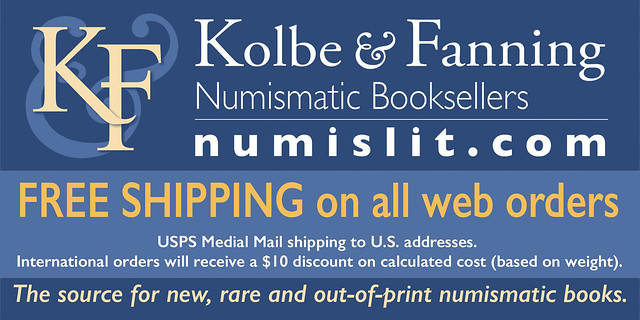
WHY WERE 1883 NICKELS ISSUED WITHOUT CENTS?
Last week Jonathan Kern asked about a story that the 1883 No Cents Nickels "were held in the treasury until 1933" and "When released in 1933 or 1934 they were an instant anomaly to the public in an era of buffalo nickels, and saved." -Editor
Author Roger Burdette writes:
"There is no evidence that 1883 no-cents nickels were withheld from circulation in 1883, or issued decades later to a confused public. First issue was on February 1, 1883 total value of $5,120. Coins with “cents” added were not released until April 13. Total coinage including proofs issued in 1883 was:
Shield 1,456,919
Liberty no cents 5,479,519
Liberty w/cents 16,032,983
"Production of Liberty nickels was so large during the first two years that by 1885 the Treasury was awash in excess coins.
"[See my Coin World article, “Why Were 1883 Nickels Issued Without Cents?” for details about unusual circumstances surrounding the new coins.]"
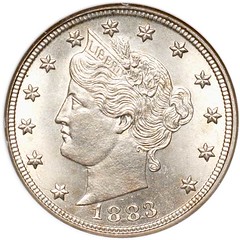
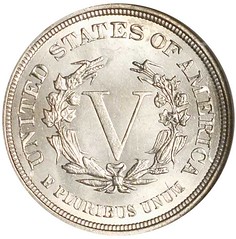
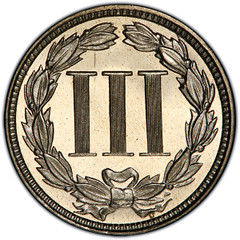 Roger kindly shared a copy of his article. Thanks. Here's an excerpt. To answer the question of "Why Were 1883 Nickels Issued Without Cents?", in short - because Mint Director Snowden was adamant that the Roman numeral was
sufficient designation of value. Note that the three-cent nickels, issued from 1865-1889, bore only the Roman numeral III and no "cents" either. [Image from PCGS CoinFacts] -Editor
Roger kindly shared a copy of his article. Thanks. Here's an excerpt. To answer the question of "Why Were 1883 Nickels Issued Without Cents?", in short - because Mint Director Snowden was adamant that the Roman numeral was
sufficient designation of value. Note that the three-cent nickels, issued from 1865-1889, bore only the Roman numeral III and no "cents" either. [Image from PCGS CoinFacts] -Editor
By 1881, with Snowden firmly in charge at the Philadelphia Mint and a relatively weak, inexperienced Mint Director, Horatio C. Burchard, in place at Washington headquarters, the Superintendent had opportunity to impart his personal ideas for coin design. In late 1881 he wrote to the director explaining his philosophy and designs for minor coins.
After outlining the confused history of minor coin designs and alloys, Snowden proposed a basic uniform design for 1-, 3-, and 5-cent pieces, similar to one offered in 1868.
Snowden’s basic design specifications: “The devices were to be uniform on the obverse and also uniform in character on the reverse. The obverse was to be the head of Liberty surrounded by the words “United States of America”, and on the reverse, a wreath composed of cotton, rice, tobacco, and wheat, the products of the country, surrounding the Roman numerals indicating the nominal value of the piece,” were evidently given to Engraver Charles Barber, who dutifully prepared finished designs and pattern pieces. These 1881 pattern cent, three cent and five cent pieces share Snowden’s simple design, including use of a Roman numeral as the only designation of value.
Figure 2. Snowden’s minor coin designs as sculpted by Charles Barber. These are Judd 1665, J-1668 and J-1671, top to bottom. (Illustrations courtesy Heritage Auctions HA.com.)
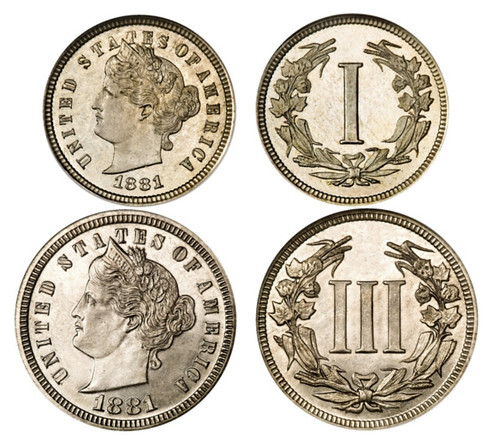
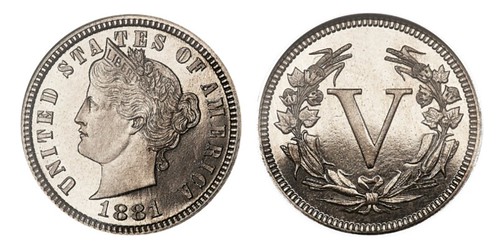
To read the earlier E-Sylum article, see:
NOTES FROM E-SYLUM READERS: MAY 3, 2020 : Were 1883 No Cents Nickels Released in 1930s? (https://www.coinbooks.org/v23/esylum_v23n18a22.html)
WEST VIRGINIA ‘CREATE A QUARTER’ ART CONTEST
High school juniors in the state of West Virginia recently participated in ‘Create a Quarter’ art contest. -Editor
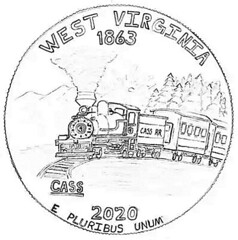
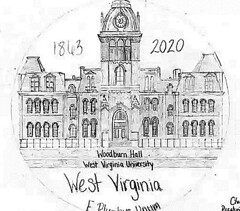
Six years ago, West Virginia First Lady Cathy Justice started the Student Artist Series, in which students are challenged to display their artistic abilities in a themed contest.
This year’s theme was “Create a Quarter for West Virginia” in honor of President’s Day.
All high school juniors in the state were invited to participate in the contest and to create a design that they felt symbolized West Virginia to be used on the reverse side of a quarter.
At this time, West Virginia is represented by the New River Gorge Bridge in the United States Mint’s 50 State Quarters program.
Students were asked to use an art medium of their choice and create a scene that included the state’s name, the year it became a state, the location depicted in the image, the current year and the Latin phrase E Pluribus Unum.
To read the complete article, see:
PCHS students participate in ‘Create a Quarter’ contest (https://pocahontastimes.com/pchs-students-participate-in-create-a-quarter-contest/)

THE ERROR THAT WASN'T
An article by Bill Fivaz titled "Everything Is Not What It Seems To Be" was published in the March-April 2020 issue of ErrorScope, the official publication of the Combined Organizations of Numismatic Error Collectors of America (CONECA). With permission, we're republishing it here. Thanks to Bill and ErrorScope editor Allan Anderson for furnishing the text and images. -Editor
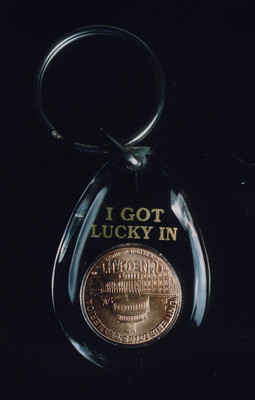 The Scene: Metropolitan Coin Club Meeting, Atlanta, GA
The Scene: Metropolitan Coin Club Meeting, Atlanta, GA
The Time: Saturday, March 2, 2019
The Subject: Incredible Multi-struck Lincoln Cent
Sitting at my mini-bourse table at a recent coin club meeting, a young man approached and said he had been referred to me by another club member. He said he had a coin that he thought “was something special”.
Danny explained that he had purchased the coin (in a plastic key ring) at the souvenir shop at the U.S. Mint headquarters in Washington, D.C. He noticed that it just “didn’t look right” and asked me what I thought.
When I looked at it, it was a lovely bright uncirculated example of the fourth and scarcest design of the 2009 Lincoln cent special series from the Denver mint, the Presidency design, with the reverse showing the unfinished Capitol building. Looking at it more closely, I saw that it had been multi struck in collar, with at least three of the strikes in step fashion, close together, and another struck with about a 10-degree rotation. WOW!!!
On the obverse, LIBERTY was strongly doubled to the south and the 2009 date was doubled to the north. On the reverse, the multi strike was much more apparent with repeat images all over the place. I could see staggered images throughout ONE CENT and the Capitol building which was astounding.
Danny agreed to sell the coin to me and I was anxious to check it out further. After taking several photos of the coin in the plastic holder, I thought to myself: “How prophetic it was that this young man bought this thing in a holder that said ‘I GOT LUCKY IN WASHINGTON, D.C.’!’
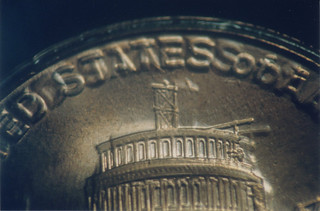 After taking the pictures, I decided to call Fred Weinberg to see if any major errors had been reported on this 4-coin series. Fred said no, only a couple slightly off-center pieces and a partial collar - no “biggies”. Another
WOW!!!
After taking the pictures, I decided to call Fred Weinberg to see if any major errors had been reported on this 4-coin series. Fred said no, only a couple slightly off-center pieces and a partial collar - no “biggies”. Another
WOW!!!
I then decided to take the coin out of the plastic key ring to get better images for publication. When the coin was extricated and I looked at it, the balloon popped, the wind came out of the sails and my stomach turned flip-flops. The coin was a normal 2009-D cent!
What happened?!
I soon realized, after now looking at the opened plastic container, that the “multi-strikes” I had seen were actually, impressions of the coin on each side of the plastic. Evidently, when the coin was heat sealed in the key ring, it had shifted a bit, creating the multi-strike I saw “on the coin”. Dadgum it!!!
It just goes to show you that sometimes things are not as they seem to be, and I was negligent in not following through as I should have to ensure the error was an error and not a normal coin masquerading as such in a plastic surrounding. Lesson learned.
P.S. And yes, Danny was (and is) very pleased with the money he received for the “error”!
For more information about the Combined Organizations of Numismatic Error Collectors of America (CONECA), see:
https://conecaonline.org/
THE BOOK BAZARRE
CIVIL WAR ERA SANITARY FAIR NUMISMATICA
An article by Dave Schenkman in the Spring 2020 Civil War Token Journal from the Civil War Token Journal Society discusses the numismatica of Civil War Sanitary Fairs. With permission, here's an excerpt. Thanks to Jennifer Meers and CTWS President Susan Trask for providing the images and text. -Editor
NUMISMATICA OF THE CIVIL WAR ERA SANITARY FAIRS AND RELATED ORGANIZATIONS
David E. Schenkman
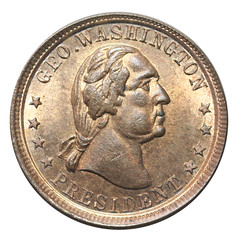
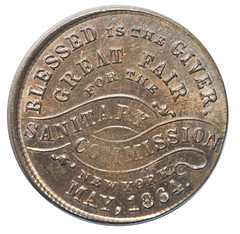
New York Civil War token
During the Crimean War of 1853-1856, the British Secretary of War authorized Florence Nightingale (who later established the world’s first secular nursing school and is considered the creator of modern nursing), to visit the battlefield to care for injured troops. What she and the nearly 40 nurses that went with her discovered was an appalling situation, with by far the majority of deaths coming from diseases rather than battle wounds. The British eventually sent a sanitary commission to help improve conditions at the camps.
The idea for a United States Sanitary Commission came from the British organization. According to Kantor, author of a book that is primarily concerned with the numerous stamps and covers emanating from the various fairs during the Civil War era, two Union soldiers were perishing from diseases for every one dying from combat. The United States Sanitary Commission was officially established on June 18, 1861, by federal legislation, and branch associations rapidly sprang up in numerous other cities.
The Commission was a private relief organization, its purpose being to improve living conditions for military personnel. They established about 30 rest homes for injured and traveling soldiers, staffed hospitals and hospital ships, and many other related projects. During the war they distributed more than $15 million to military camps, hospitals, prisons, etc.
More than 15,000 women volunteered their services to work at hospitals and aid centers during the Civil War. They also raised money by collecting donations, making uniforms, comforting the sick and dying, and were instrumental in organizing the sanitary fairs. Famous women, including novelist Louisa May Alcott and author Katherine Prescott Wormeley, lent their services to the effort.
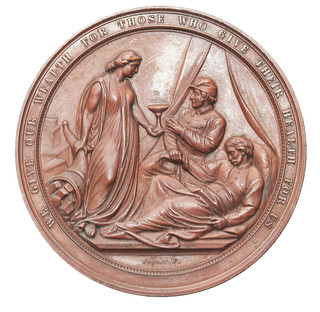
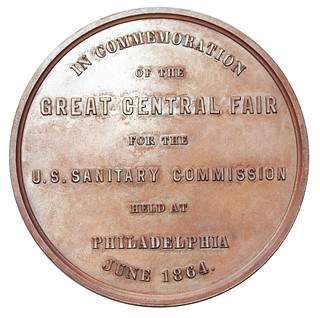
Philadelphia Sanitary Commission medal
Money to aid wounded and disabled soldiers was raised in many ways, some of them quite unconventional. In 1864 an Austin, Nevada general store owner by the name of Reuel Colt Gridley made a wager on the outcome of the local mayoral election with a friend, wherein the loser had to walk through town accompanied by the local band, carrying a 50 pound bag of flour. Gridley won the bet; after it was “paid” it was suggested that he auction off the bag, with the proceeds going to the Sanitary Fund. The high bidder donated it back to be re-auctioned, and each high bidder thereafter did the same, until more than $8,000 was raised.
For more information on the Civil War Token Journal Society, see:
http://cwtsociety.com/
THE TRISTRAM COFFIN MEDAL
Here's another article I came across while reviewing The Historical Magazine for the Newman Numismatic Portal. Transcribed by NNP's Kelli West, it's about a childhood discovery of a c1826 medal. I added images from Heritage and paragraph breaks for readability. -Editor
THE HISTORICAL MAGAZINE.
VOL. VIII. No. 8.
AUGUST, 1864.
Notes and Queries.
NOTES.
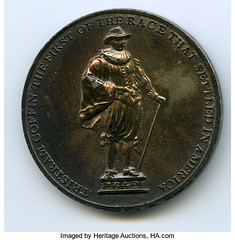
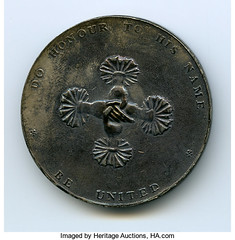
THE TRISTRAM COFFIN MEDAL.- Several years ago, I, with some other little boys, was whiling away a summer afternoon, in the delightful employment of digging holes in my father’s door-yard and filling them with water, which holes thus filled we dignified with the name of “wells.” While engaged in excavating a “well” which was to be a grand affair, and which I had already sunk to the depth of a foot or more, I struck upon something smooth and glistening, and soon brought up de profundis a medal of large size which was regarded by us all as an object of great curiosity, and led to many childish speculations as to the manner in which it came to be buried in this locality. Well-digging ceased to interest us from that moment, and we forthwith became a company of money-diggers. Although our further efforts were unsuccessful, yet the appearance of the door-yard when we ceased our operations was more suggestive of a ploughed field than of a well kept grass-plot. My recollection of the appearance of this medal, which I have not seen for twenty five years, is this.
On the obverse was the effigy of a man in the dress of a cavalier. The hat on his head was adorned with a feather; the wrists were surrounded with ruffles; the trousers were met at the knee by long stockings; and the feet were enclosed in buckled shoes. The legend was in these words:- “Tristram Coffin, the first of the race that settled in America.” On the reverse were two hands clasped, the wrists ending in ruffles, but the legend if there was any I do not remember. In size the medal was larger than a crown piece, and was struck either in silver, tin or white medal.
At that time a young man by the name of Coffin was a clerk in my father’s office, and to him, on my father’s suggestion, I gave the medal. Since then I have often made inquiries as to the origin and history of this memorial piece, but have never yet seen a satisfactory account of it. That Tristram Coffin was the first of his race that settled in America, there can be no doubt. In the second volume of the New England Genealogical Register may be found statements respecting his history, and in Dr. F. B. Hough’s compilation of “Papers relating to the island of Nantucket,” a copy of his signature is given, several of his letters are presented, and his importance as one of ten owners of Martha’s Vineyard and as a local magistrate is recorded. If my friend who has the piece which rewarded my early efforts in well-digging, or if any of your readers can throw light on this subject, the information will afford me much pleasure.
B.H.H.
Troy, May 25, 1864.
To read the Heritage lot description, see:
(1826) Tristram Coffin Medal, Betts-533, Cast....
(https://coins.ha.com/itm/betts-medals/-1826-tristram-coffin-medal-betts-533-cast/a/1235-98510.s)
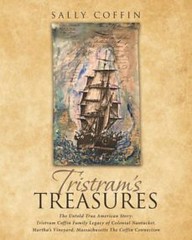 What caught my eye was the legend "The First of the Race That Settled in America". The phrase "first of the race" made me wonder if the subject was a person of color, likely enslaved. But I learned that Coffin was an
Englishman of the landed gentry who settled in Nantucket in 1642. I guess "race" in this case is referring to Englishmen. The medal is listed in Betts (Betts-533). I reached out to some readers for comments. -Editor
What caught my eye was the legend "The First of the Race That Settled in America". The phrase "first of the race" made me wonder if the subject was a person of color, likely enslaved. But I learned that Coffin was an
Englishman of the landed gentry who settled in Nantucket in 1642. I guess "race" in this case is referring to Englishmen. The medal is listed in Betts (Betts-533). I reached out to some readers for comments. -Editor
John Sallay writes:
"I don’t know much about this medal beyond the excellent history put together by John Kraljevich in his cataloguing of the LaRivierre Collection pieces (Part II, Bowers & Merena, March 16, 2001, lots 2128 and 2129).
"I never really thought of this as a school medal, but having now just re-read John’s description I probably ought to start keeping my eyes open for a nice copper example, which John says were distributed to scholars at the Lancastrian school on Nantucket."
John Kraljevich writes:
"Not only do I love this medal, I’m also a Tristram Coffin descendant!
"Be aware there are different generations of these things. The struck AE originals by Thomason are from 1827 - I know of a gilt AE in a presentation box too (ex LaRiviere, now CWF). But family reunions on Nantucket distributed cast copies from the late 19th through early 20th century - these are pretty obviously cast.
I have several different generations in my own collection. At one point I had 2 original strikings in stock and nobody wanted them. I think I ended up selling both for a loss. Pity too - they’re rare medals!"
John Adams writes:
"Thirty years ago, my neighbor down the block was Tristram Coffin, a direct descendant. I sold him my medal and later bought another."
How cool is that? Thanks, everyone. -Editor
To read the LaRivierre Collection collection lot descriptions, see the Newman Numismatic Portal (page 211-212):
The Cabinet of Lucien M. LaRiviere: Part II (https://nnp.wustl.edu/library/auctionlots?AucCoId=4&AuctionId=524060)
For more information on Tristram Coffin, see:
Tristram Coffin (settler) (https://en.wikipedia.org/wiki/Tristram_Coffin_(settler))
TRISTRAMS TREASURES SALLY COFFIN- (https://www.casadellibro.com/libro-tristrams-treasures/9781635258646/7094190)

VICTORIA CROSS NOT MADE FROM CAPTURED GUNS
If you repeat a story often enough it comes to be seen as true. And in time it can actually come true. One researcher looked into the story of where the metal for Victoria Cross medals came from. Here's an excerpt from The Guardian. -Editor
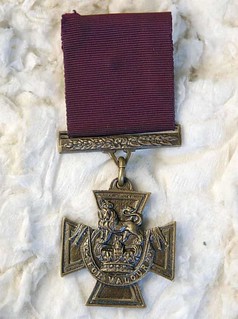 The Victoria Cross, or VC as it is popularly known, is the most cherished award in the British armed forces, awarded since 1857 for courage displayed “in the presence of the enemy”.
The Victoria Cross, or VC as it is popularly known, is the most cherished award in the British armed forces, awarded since 1857 for courage displayed “in the presence of the enemy”.
Its long history is filled with true stories of great bravery. But one long-held belief – that Victoria Cross medals were made from enemy guns captured during the Crimean war against Russia – is unlikely to be true, and originated instead from speculation in the press, according to new research.
Instituted by Queen Victoria, the Victoria Cross is Britain’s highest award for valour in war and has been awarded 1,358 times.
Dr Andrew Marriott, a retired lieutenant colonel and visiting researcher at Newcastle University, has concluded that it is “highly implausible” that the medals came from Russian guns after the victory at the siege of Sevastapol in 1855. His research led him to a newspaper report at the time, asserting that they did come from the captured guns. He also found a letter in the Times from a Crimean veteran suggesting the same thing, and so, he says, the myth was born.
Using x-ray fluorescence scans to examine the composition of Victoria Cross medals from 1856 to 2013, the research showed that part-way through the first world war, and again during the second world war, there were noticeable changes in composition, when compared with the 19th-century medals.
The only contemporary record of a Sevastopol connection is a newspaper report of the medal ceremony in Hyde Park in 1857. The correspondent most likely conflated various stories circulating about the redistribution and recycling of captured Crimean guns.”
The 64-year-old, who spent 30 years in the Royal Regiment of Fusiliers, explained that Hancocks Jewellers in London has been the sole producer of the medal since its inception.
But during the first world war, Hancocks was forced to ask the War Office for a resupply of metal and, believing the myth that had been created, they turned to captured guns.
Marriott said: “Hancocks were running out of metal so asked the War Office for a resupply and it’s probable that staff in the War Office, who were probably thinking about other things than the Victoria Cross, looked at each other and asked, where do you get this metal from? By then there would have been a tradition about Sevastopol guns, so a delegation would have been sent to cut off bits of guns to supply to Hancocks.”
The current source of Victoria Cross metal is thought to be a cascabel – the round protrusion at the back of a cannon – stored at a Ministry of Defence depot in Donnington, Shropshire. Published in Post-Medieval Archaeology, the research found historical evidence that this cascabel may have been taken from a gun captured during the second Anglo-Chinese war of 1860, three years after the first Victoria Cross awards were made.
“While it’s unlikely that even the earliest medals came from the ordnance captured at Sevastopol, it is clear that most of the VCs awarded since the first world war have plausibly been sourced from the cascabels of captured guns – an important and symbolic fact for those who have received the honour in recognition of their bravery,” Marriott said.
To read the complete article, see:
Show your mettle: Victoria Cross not made of captured Russian guns after all
(https://www.theguardian.com/uk-news/2020/may/03/show-your-mettle-victoria-cross-not-made-of-captured-russian-guns-after-all)
THE MEMENTO MORI MEDAL
We have plenty of reminders of mortality these days, and it's an old theme in art and literature. Here's a medal designed as a pocket piece. -Editor
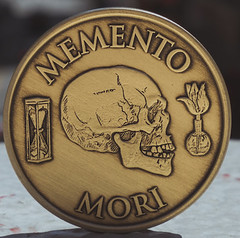 These coins are designed with the intention of carrying them in your pocket, a literal and inescapable reminder that “you could leave life right now.”
These coins are designed with the intention of carrying them in your pocket, a literal and inescapable reminder that “you could leave life right now.”
In Meditations Marcus Aurelius wrote “You could leave life right now. Let that determine what you do and say and think.” That was a personal reminder to continue living a life of virtue NOW, and not wait. The French painter Philippe de Champaigne expressed a similar sentiment in his painting "Still Life with a Skull," which showed the three essentials of existence - the tulip (life), the skull (death), and the hourglass (time). The original painting is part of a genre referred to as Vanitas, a form of 17th century artwork featuring symbols of mortality which encourage reflection on the meaning and fleetingness of life.
Each coin is handcrafted in the United States by a custom mint operating in Minnesota since 1882. The same mint where the iconic AA anniversary medallions were created in 1973 by Bill Westman, an employee. Westman wanted to create something to leave with people he interacted with in recovery groups and to mark their achievements in sobriety. To remind them of the messages of AA and help keep them on their road to recovery. Westman’s advice was “carry this in your pocket or purse and when temptation is great, reach into your pocket and feel the medallion and remember your struggle to get this far.”
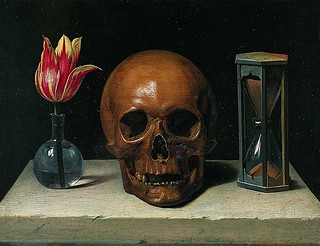 The front features an interpretation of de Champaigne’s 17th century painting and the back shows a shortened version of Aurelius’s timeless wisdom. The coin acts as a reminder to not obsess over trivialities, or trying to become famous,
make more money than we could ever spend, or make plans far off in the future. All these are negated by death. It’s time we stop pretending otherwise.
The front features an interpretation of de Champaigne’s 17th century painting and the back shows a shortened version of Aurelius’s timeless wisdom. The coin acts as a reminder to not obsess over trivialities, or trying to become famous,
make more money than we could ever spend, or make plans far off in the future. All these are negated by death. It’s time we stop pretending otherwise.
To read the complete product description, see:
MEMENTO MORI (https://store.dailystoic.com/products/memento-mori)
For more information on the Vanitas genre, see this May 7, 2020 Paris Review article:
Still Life (https://www.theparisreview.org/blog/2020/05/07/still-life/#more-144859)
The referenced Mint is likely Wendell’s of Ramsey, MN, makers of custom challenge coins, medals, badges, signage and other products. Here's an excerpt from their history page. -Editor
In 1882, Wendell’s opened for business in Downtown Minneapolis. Minneapolis was far different in 1882; a thriving city of 43,000 people fueled by the grain milling and lumber industries yet very much on the edge of the frontier. Wendell’s manufactured rubber stamps, stencils and steel engraving for local industry from a small office on Hennepin Avenue, around the block from the original location of the Minneapolis City Hall.
In 1940, Jim Barnum and Bill Bryant took over the management of the company and in 1945, they completed the purchase of the company. In the post-war years, Wendell’s continued to grow by acquiring other stamp, stencil and seal companies but the owners felt that they needed products with a national market to support their growth. Added to their product line were buttons, badges and regalia, the beginnings of the Wendell’s Custom Products line.
After 67 years in the heart of downtown, Wendell’s moved to a new Minneapolis location that allowed more room for the increased production capability the new product lines required. Wendell’s continued to grow acquiring four additional regional competitors, adding their long history to the traditions of Wendell’s. In 1982, Wendell’s quietly celebrated their 100th year of business with an optimistic look to the future.
An interesting highlight of Wendell’s history is their role in the treatment, recovery and ongoing success of millions of people worldwide who have fought and are winning the battle against addiction. In 1973, a Wendell’s employee Bill Westman, himself a recovering alcoholic was active speaking and counseling others seeking treatment. Bill wanted something that he could leave with those to whom he spoke, something to remind them of the message of AA and to encourage their continued healing. Bill developed a medallion with a raised center and the raised center anniversary medallion has become one of the more visible and lasting traditions of the AA movement, recognized the world over.
To visit the Wendell's web site, see:
http://www.wendellsinc.com/

IRAN'S CURRENCY CHANGE
Pablo Hoffman of New York City passed along this New York Times article on Iran's upcoming currency revaluation. -Editor
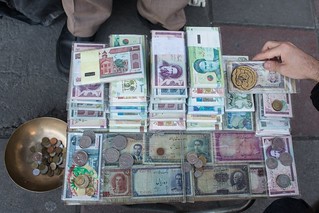 For many years, Iran’s government debated changing the national currency, the rial, by basically slashing four zeros off its face value — an acknowledgment of how American sanctions and economic mismanagement have contributed to inflation
in the country.
For many years, Iran’s government debated changing the national currency, the rial, by basically slashing four zeros off its face value — an acknowledgment of how American sanctions and economic mismanagement have contributed to inflation
in the country.
On Monday, the Iranian Parliament essentially took that step, authorizing the replacement of the rial with another basic unit of currency called the toman. Each toman will be worth 10,000 rials under the new system.
The coronavirus pandemic, which turned Iran into a regional epicenter of the disease, appears to have played a decisive role, contributing to a further devaluation of the rial since February.
Since 2018 when the Trump administration repudiated the nuclear agreement and reimposed sanctions on Iran, the value of Iran’s currency has fallen by roughly 60 percent.
The change is the outcome of a draft bill presented in early 2019 by the governor of Iran’s central bank, Abdolnasser Hemati. He noted that the currency has been devalued 3,500 times since 1971 and that Iran had no choice but to “save the face” of its national currency, according to Iranian official media reports. Earlier attempts by President Hassan Rouhani’s government to change the currency as far back as 2016 had remained in limbo.
Supporters of the change said slashing the extra zeros would vastly simplify financial calculations in Iran by eliminating the need for Iranian shoppers to carry loads of rials to make purchases, which they must do now because of inflation. On Monday the rial’s exchange rate was 156,000 to the dollar.
But opponents argued that the plan was an added expense at a time when the government was already facing a budget deficit of between 30 to 50 percent for this coming fiscal year. The effect of the currency change, the critics said, amounted to just cosmetic window dressing.
“You typically fix the economy first and then change the currency,” said Mr. Khavand. “The government is in a financial bind with no prospect of financial aid coming from outside or from inside so they are trying this.”
To read the complete article, see:
With Inflation Ravaging Currency, Iran Is Changing Names and Numbers
(https://www.nytimes.com/2020/05/04/world/middleeast/iran-currency-inflation-rial-toman.html)
ITALIAN TOWN ISSUES ‘DUCATI’ BANKNOTES
Regarding an earlier article on community currency, Jerry Norton writes:"Kind of reminds me of store cards."
Well, one difference is that store cards are generally issued by a single merchant, although there are isolated examples of paper scrip issued and redeemable through a small group of local merchants. Community currencies are generally issued by an entire town or a nonprofit organization associated with the town.
A mountain town in southern Italy has issued a community currency to help locals through the coronavirus pandemic. -Editor
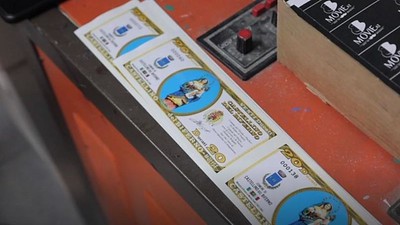
The small Italian town of Castellino del Biferno has begun minting its own banknotes in a bid to help residents struggling to make ends meet during the COVID-19 lockdown.
The town, which has just 550 residents, is handing the ‘Ducati’ notes out to residents based upon their economic needs.
The notes can be spent at local shops for food and necessities, with the shops returning the notes to the town council upon which they are reimbursed for their sales.
The denominations of the notes is exactly the same as a Euro, five Ducati is five Euro and 20 Ducati is 20 Euro and so on. The move was agreed to help the elderly, who need the help the most, understand the new currency.
The mayor of Castellino del Biferno received a grant of €5,500 from the government to issue food vouchers to vulnerable families during the pandemic. The town council added its savings and distributed "Ducati" banknotes to over 200 families in town.
The mayor of the town hopes the notes will do more than just help people buy everyday items. It’s reported that he sees the crisis money as an opportunity to increase the town's sense of belonging. To try and do that, the banknotes depict local symbols like the church, the public swimming pool, and also the statue of the Virgin Mary.
To read the complete article, see:
‘DUCATI’ BANKNOTES ISSUED TO ITALIAN TOWN RESIDENTS
(https://www.visordown.com/news/general/%E2%80%98ducati%E2%80%99-banknotes-issued-italian-town-residents)
To read the earlier E-Sylum article, see:
LOOSE CHANGE: MAY 3, 2020 : Community Currencies (https://www.coinbooks.org/v23/esylum_v23n18a32.html)

TENINO REVIVES WOODEN MONEY
A couple months ago, just after the coronavirus pandemic declaration, we discussed the wooden money of Tenino, WA. Born as a Great Depression necessity currency, the originals are valuable collectibles, and a few merchants were still making and honoring wooden notes as a novel community currency. But hard times are back, and the whole town is now back in the game. Found via News & Notes Volume V, Number 46, May 5, 2020 from the Society of Paper Money Collectors. -Editor
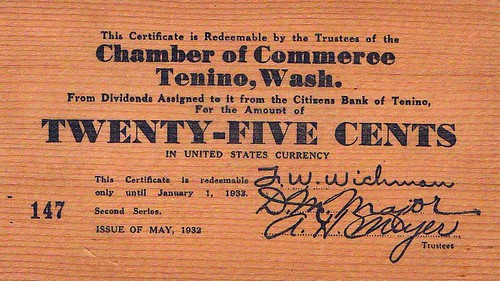
During the depths of the Great Depression, the small Thurston County town of Tenino drew national attention when it printed thousands of dollars of wooden money to keep the local economy afloat.
Now, facing what could be the worst economic downturn since that time, the Tenino City Council drew on history last week when it approved an ordinance authorizing up to $10,000 worth of wooden scrip.
Residents of Tenino who meet income limits modeled after federal poverty guidelines and who can show financial harm caused by the novel coronavirus crisis could receive up to $300 each month in scrip backed by the city general fund for use at local retailers. City staff could begin screening applications as soon as Monday.
“During the Depression, Tenino took unprecedented initiative by printing and issuing its own currency,” Tenino Mayor Wayne Fournier said. “Here we are again, many years later, doing the same thing. Smaller communities all too often are left to fend for themselves and slip through the cracks, but this type of situation can also breed resilience and independence.”
Tenino leaders first came up with the concept of wooden currency in response to the closure of the local bank in late 1931. Local residents signed promissory notes obligating themselves to reimburse the local chamber of commerce once the bank reopened.
The notes caused a stir, with many municipalities undertaking similar measures to prop up their economies. Currency collectors continue to reach out to city officials to this day in search of original prints and often trade the notes via online auction.
The modern scrip is backed by agreements between local merchants and the city itself. Customers will use the currency in $25 increments to purchase anything other than products containing alcohol, tobacco or cannabis. Vendors will then turn the coupons into the city in exchange for a check.
The new scrip will feature an updated design, but will be produced using the same type of rolled cedar and on the same machinery used nearly 90 years ago.
Millard said that for a family of two making up to $1,437 per month, the city would supply scrip coupons worth $300. Those making up to $1,911 would receive $250, with families that reach higher benchmarks still eligible to receive smaller grants. City attorneys have reviewed the program to ensure it does not violate laws against the gifting of public funds, Millard said, but the city wants a concurring opinion from the State Auditor’s Office before it begins distribution.
The city council approved an initial limit of $10,000 worth of wooden money, but could vote later to increase the dollar amount based on demand and the limits of the city’s own coffers.
To read the complete article, see:
Tenino to replicate Depression-era printing of wooden currency to support economy (https://www.theolympian.com/news/local/article242464236.html)
Now here's a first-class numismatic item born of the current crisis. The most important thing is taking care of the local families, but some of these newly-issued notes should find a place in major collections. -Editor
To read the earlier E-Sylum article, see:
TENINO IS STILL PRINTING WOODEN MONEY (https://www.coinbooks.org/v23/esylum_v23n11a23.html)
FAUX DOUGH: MOVIE PROP MONEY
Rick Reed's Currency Banknotes May 2020 Newsletter offers "Stage Money" - prop notes used in stage and film to represent the Real McCoy. Here's an excerpt. -Editor
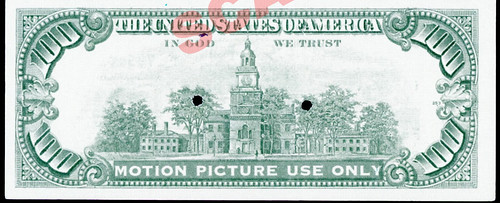
Ocean's Eleven $100 old style Federal Reserve Note prop
We have been surprisingly busy throughout much of this period, although ebay has been a bit slow of late. But, it seems more people are ordering from www.CurrencyBanknotes.com now, which is great. Thanks so much for all the wonderful orders - we appreciate it very much!
In February, we attended a few more shows and picked up some more world banknotes from our favorite local dealers. The past three months have also been busy for our fantasy art note division, as customers have been eagerly snapping up examples of the newest creations, as well as some old favorites. The printer also just completed printing a few new varieties that had been requested.
I mentioned last time we would also be adding in some neat and collectible (mostly old) Hollywood movie prop money to the site as well and you can see some new examples in our Latest Additions area. For years we have had many prop bills on ebay, and did pretty well with them (we purchased a treasure trove of these back in 2001). As I previously stated, it seems ebay is becoming less tolerant of these film/tv artifacts as true collectibles and instead applying their outlandish rules on replicas to them, with the result that many of them got removed and so we have not been relisting them there, just on our website now. This is also happening with many other items we sell - making it too expensive and time-consuming to list them all on ebay but go on the website much easier and don't cost us for each item; it's just a flat rate for hosting the site. We consider ebay a good recruitment field for our much more comprehensive website. So it will pay you to shop here!
As time allows, we are adding in new items of all types and price ranges to the site. We have lots of inventory we are still sorting through. Recently started going through some prop material we received over the past several years and its like Christmas every time we look. Lots of interesting and fascinating new pieces, like the 100 dollar notes used in the 2001 film "Ocean's Eleven," and numerous other examples of faux dough used in tv, movies, and on stage.
The eBay policy is understandable given the rash of reports of people buying fake notes labeled "MOTION PICTURE MONEY" online and trying to spend them. It's a nuisance for merchants and law enforcement alike despite the ease of identifying them.
Rick adds:
"I agree that prop notes can be a nuisance to merchants at times and some can be a bit deceptive. However, eBay has a knack for kicking off props and some novelty bills that don’t in any way, shape, or form resemble current (or even former) negotiable notes. Some of the items they tossed off more closely resemble coupons than currency. So that gets a bit annoying too. Especially when Chinese (and other) sellers are allowed to sell blatantly counterfeit items on there without any disclaimer on them. Of course, when they banned the sale of replica coins marked “COPY” on there, people just started selling unmarked replicas (i. e. counterfeits) and called them “commemoratives.”
Fred Reed's landmark catalog Show Me The Money is the standard reference, and its genesis was here in The E-Sylum. Check out Rick's site for more. But first, here are a couple examples from the newsletter. -Editor
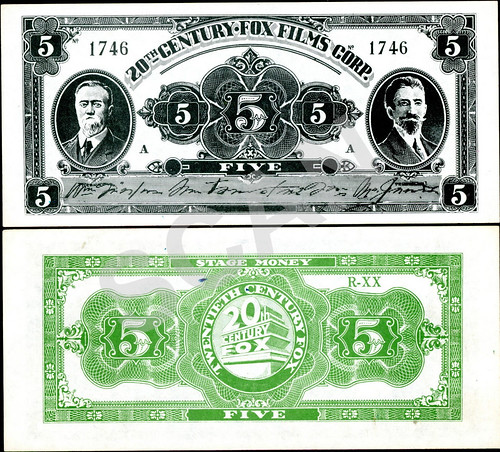
20th Century-Fox Films Corp. "stage money" style prop acquired from Ellis Props Sale in 2000. Listed in Fred Reed's landmark catalog "Show Me The Money." Scarce - only a couple left in stock!
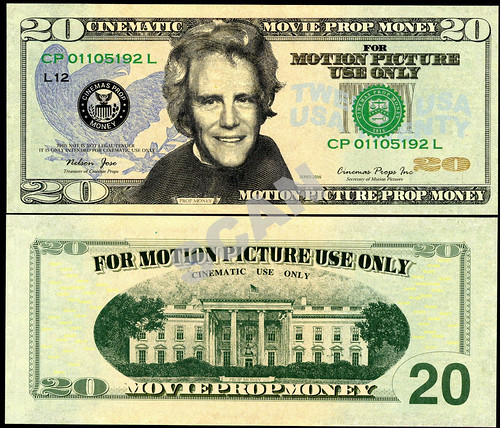
US $20 style (series 2016) Cinematic Movie Prop Money, with a "smiling Andrew Jackson," actually someone else's mug substituted for Old Hickory. A well-done, professionally printed piece, not shown in Fred Reed's "Show Me The Money" catalog of movie prop money as it was created well after the catalog came out. Could easily pass as the real thing from a distance, but easily recognizable as a prop bill with many disclaimers in all the titles.
To visit Rick's CurrencyBanknotes.com, see:
Movie Prop Money (https://currencybanknotes.com/banknotecountry.php?countryid=322&funnote=1)

THE QUEEN'S STAMP COLLECTION
Len Augsburger passed along this story about the Queen's £100 million stamp collection. Thanks. -Editor
The Royal Philatelic Collection is the British royal family’s name for the queen’s stamp collection which is made up of hundreds of boxes and albums filled with rare, valuable, and historic stamps. The albums are color-coded by monarch; red for King George V, blue for King George VI, and green for Queen Elizabeth.
King George V started collecting stamps in the late 1800s when he’d still been the Duke of York, according to the Smithsonian National Postal Museum. When he took up the hobby, he enlisted the help of his uncle, Prince Alfred, Duke of Edinburgh, who had originally started the royal stamp collection in 1864.
Over time, King George V became very interested in the hobby. Whenever he visited London, the king reportedly spent up to three afternoons a week working on the collection, once remarking he wanted the best stamp collection not just one of the best.
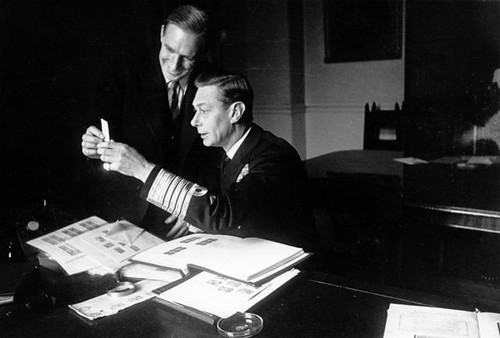
King George VI looks through stamps with the Curator of the Royal Stamp Collection
After King George V, King George VI took up the hobby and grew the stamp collection even more. Then came Queen Elizabeth who made it what it is today.
As The Sun reported, the queen is the fifth monarch to inherit the royal stamp collection. While we don’t know for sure, if Queen Elizabeth were to keep with royal tradition, she would leave the Royal Philatelic Collection to her oldest son, Charles, Prince of Wales, who is first in the royal family’s line of succession. However, we won’t know who will inherit the stamp collection until the queen’s demise.
The queen is said to be partial to giving guests a look at her stamp collection when they stay at Buckingham Palace.
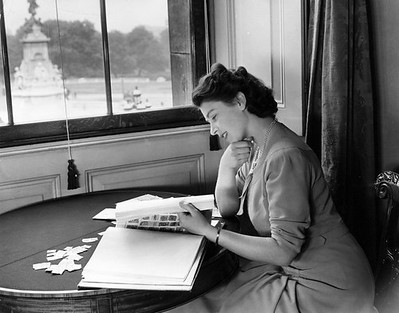
Queen Elizabeth II looks at stamps
To read the complete article, see:
Who Will Inherit the Queen’s £100 Million Stamp Collection When She Dies?
(https://www.cheatsheet.com/entertainment/who-will-inherit-queens-100-million-stamp-collection-when-she-dies.html/)
CHINA’S DIGITAL CURRENCY
Kavan Ratnatunga forwarded two articles on China’s Digital Currency plans. Thanks. -Editor
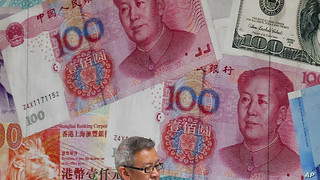 For two days in a row last week, amid coronavirus-related market meltdowns, a group of stocks on China’s main exchange moved so significantly that they triggered automatic circuit-breakers designed to halt trading. But trading was
suspended not because the stocks plummeted. It was because they soared.
For two days in a row last week, amid coronavirus-related market meltdowns, a group of stocks on China’s main exchange moved so significantly that they triggered automatic circuit-breakers designed to halt trading. But trading was
suspended not because the stocks plummeted. It was because they soared.
The explosive rally of digital currency-related stocks followed news that after several years of anticipation, China’s government released a timeline for rolling out its new digital currency in four cities.
In the next month, government workers in these cities will use a smartphone application to receive at least a portion of their paychecks in the form of a digital payment, marking a milestone on the path toward the world’s first digital currency system by a major central bank.
To some experts, the digital currency could represent a serious threat to an American asset that has reigned unchallenged for decades: the U.S. dollar.
With so much of the world dependent on U.S. banking, it can mean that even companies with no U.S. operations still depend on the American financial system.
“Even a company that has basically no trade in the United States, their banks do,” Jarrett Blanc, a senior fellow at the Carnegie Endowment for International Peace, told The Atlantic last year.
Because of that unique power, organizations like Iran’s Islamic Revolutionary Guard Corps and countries like North Korea feel the bite when they are sanctioned by Washington.
Starting in 2014, China saw digital currencies as a way of shifting away from U.S. dollars. It has since made advancing digital currency technology a key national strategic goal.
National economic plans in 2016 mention advancing blockchain, the technology behind popular digital currencies such as Bitcoin.
Experts pointed out that China’s proposed digital currency bypasses the Western banking system, including SWIFT, the Belgium-based Society for Worldwide Interbank Financial Telecommunication, that enables financial institutions worldwide to securely send and receive information about transactions.
To preserve the dollar’s status, analysts have been warning recently that the United States cannot afford to let China get ahead on cryptocurrency.
Tim Morrison, a senior fellow at the Hudson Institute who served as a special assistant to President Donald Trump, told VOA that he believes the prospect of Beijing “dominating this emerging financial technology should be alarming.”
In the United States, digital currencies are still in the planning stages. Facebook announced last summer a global digital currency called Libra, but it is still trying to win approval from regulators.
Earlier in April, U.S. lawmakers introduced a bill that would authorize the Federal Reserve to create “Digital Dollar Account Wallets" called “FedAccounts” to distribute stimulus checks to business and citizens.
Although it is impossible to predict whether or when the dollar will be dethroned, an opinion piece reprinted by China's Commerce Ministry on its official website six years ago, when China began studying the development of a state digital currency, may offer a clue: "RMB will replace USD in the next 15 years," the site said.
It is a top strategic priority for China, and it seems willing to wait.
To read the complete article, see:
China’s Digital Currency Takes Shape; Will It Challenge Dollar?
(https://www.voanews.com/economy-business/chinas-digital-currency-takes-shape-will-it-challenge-dollar)
Another article:
China's grand e-currency experiment set to begin this month
(https://www.wionews.com/world/chinas-grand-e-currency-experiment-set-to-begin-this-month-296027)
THE BOOK BAZARRE
LIFE-SAVING COINS
David Pickup submitted this article about coins that have saved lives. Thank you! -Editor
Coins and Health
Continuing our look at coins and health there are other examples of how coins can be good for you. In these cases very good for you as they saved people’s lives. There are several stories of coins stopping bullets in war time. These days if you survived a shooting it would more likely be your phone that would save you.
The first example comes from the British Museum. [1]
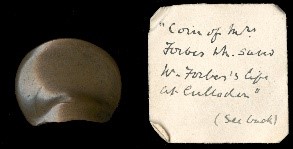
This was a coin that saved the life of a Mr Forbes at Battle of Culloden in 1745. It is not recorded what coin it was. It looks like a halfpenny. Go forward seventy years and there is an example from the Battle of Waterloo. There is no doubt this is a cartwheel penny and there is a clear impression of the musket ball. [2]
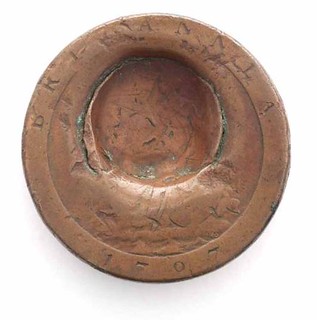
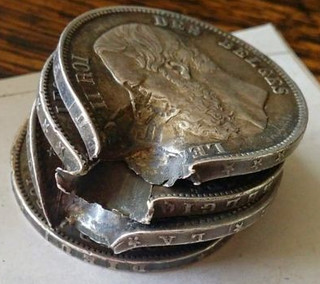
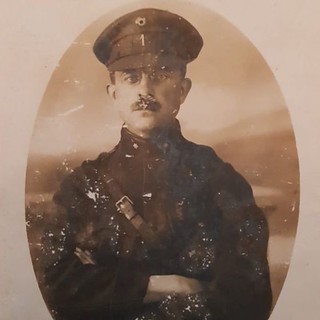
The last example is not one but a stack of silver five franc coins which saved a Belgian World War I soldier.[3] Optatius Buyssens had been carrying some loose change in the breast pocket of his jacket when he went on a reconnaissance mission near the Belgian town of Lebbeke in September 1914. The clinking of the metal in his pocket alerted nearby German soldiers, but when he came under fire, the bullet ricocheted off the coins, saving his life.
I am bit disappointed that I have not found a story about a Roman centurion whose life was saved by the denarius in his pocket which turned an angry Briton’s sword but you cannot have everything. So if you want to stay safe what is the best coin to carry in your breast pocket? Probably a cartwheel twopence I would say. Stay safe and well and do not try this at home!
Sources:
[1] https://research.britishmuseum.org/join_in/using_digital_images
/using_digital_images.aspx?asset_id=503134001&objectId=949970&partId=1 used by kind permission of the British Museum under their creative commons licence. © The Trustees of the British Museum.
[2] The E-Sylum: Volume 18, Number 5, February 1, 2015, Article 24
COIN SAVED SOLDIER'S LIFE AT BATTLE OF WATERLOO (https://www.coinbooks.org/esylum_v18n05a24.html)
[3] Both images by kind permission of Vincent Buyssens.
To read the earlier E-Sylum article, see:
COINS AS TALISMANS: SAINT GEORGE'S DAY (https://www.coinbooks.org/v23/esylum_v23n17a10.html)
UNCLAIMED PROPERTY REUNITES COINS WITH OWNER
This Washington Post article about Virginia's Unclaimed Property Division includes a happy ending to a coin collector's horror story. -Editor
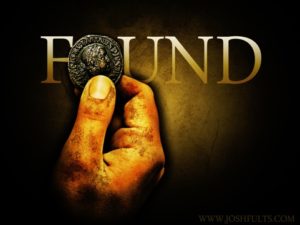 By law, Virginia’s treasury takes possession of any unclaimed tangible and intangible property from banks, insurance companies and other institutions. Anywhere from $150 million to $200 million rolls in every year.
By law, Virginia’s treasury takes possession of any unclaimed tangible and intangible property from banks, insurance companies and other institutions. Anywhere from $150 million to $200 million rolls in every year.
The scenarios that lead to the Unclaimed Property Division are about as varied as the assets there. Dividend checks get lost in the mail or land in a sock drawer. Someone misspells the name of the beneficiary on a life insurance policy or garbles the recipient’s address. People move, and utilities holding their security deposits lack forwarding addresses. An elderly parent dies, and his children never hear about the safe-deposit box he kept with coins, old bonds or other valuables.
After specified period of time — generally two to five years or more — banks, insurance companies and other such institutions are required to turn over unclaimed assets to the commonwealth’s treasury. All 50 states and the District have similar laws and programs, which are seen as consumer protections.
Virginia’s unclaimed loot has ranged from bonds issued by the Confederate States of America to ancient gold coins. Even stolen property seized by law enforcement agencies sometimes ends up in the treasury’s vault.
Then there’s the coin collector who lost some extremely valuable gold coins in 2007. He kept the coins — some of which had been struck during the Byzantine Empire — in multiple safe-deposit boxes. While sorting through them in preparation for an out-of-state move, he spread his collection out inside a Richmond-area bank vault. Somehow, he also left behind a container with 92 coins.
By the time he discovered the coins missing, he didn’t know where to look. He thought they must have been lost in the move or maybe stolen.
A decade passed. The bank turned the coins over to Virginia, and the treasury — which has only so much storage for physical property — prepared them for public auction. (The proceeds of such sales remain on the books, however, in case the claimants come forward.)
With the auction approaching, treasury staff consulted the Virginia Museum of Fine Arts in a last-ditch effort to find the owner. A museum curator — who identified all but two of the coins as genuine Byzantine currency and set their value at $200,000 or more — checked with dealers and auction houses, whose records eventually led to one very happy owner.
“Even more than the value of the coins to me is the restoration, to some degree, in humanity,” the coin collector told NBC 12.
To read the complete article, see:
Missing something? Virginia’s treasury has $2 billion that could be
yours. (https://www.washingtonpost.com/local/missing-something-virginias-treasury-has-2-billion-that-could-be-yours/2020/05/06/a9b5247c-6310-11ea-acca-80c22bbee96f_story.html)
LOOSE CHANGE: MAY 10, 2020
Here are some additional items in the media this week that may be of interest. -Editor
Selling Coins on eBay
Thinking about selling coins on eBay? David Schwager has written an excellent article on CoinWeek for newbie and wannabe eBay sellers. Some great tips and advice here. -Editor
Plenty of people love it and plenty of people hate it, but we can all agree that eBay is a major part of the coin market. The service provides opportunities for everyone from casual collectors to huge dealers to sell their items. Whether you are thinking about selling or have sold on eBay for years, here are 11 things you may not know. Most of these apply whether you sell coins or anything else.
To read the complete article, see:
11 Things You Don’t Know About Selling Coins on eBay
(https://coinweek.com/coins/coin-collecting-strategies-2/tips-for-new-collectors/11-things-you-dont-know-about-selling-coins-on-ebay/)
Hole-Fillers: Altered Dates, Replicas and Electrotypes
Speaking of eBay, there's a good thread on the CoinTalk discussion site about altered dates, replicas, electros and other hole-fillers. Here's a comment from Paul M. - see the complete discussion online. -Editor
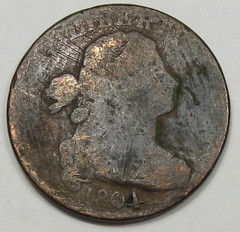 I have no idea why anyone paid nearly $150 for a heavily scratched large cent. I would say it's worth maybe the $25 suggested by the price tag in one of the images. Altered dates of this nature are commonly used as hole fillers, since
1804 is one of the key dates.
I have no idea why anyone paid nearly $150 for a heavily scratched large cent. I would say it's worth maybe the $25 suggested by the price tag in one of the images. Altered dates of this nature are commonly used as hole fillers, since
1804 is one of the key dates.
That said, there are some really nice electrotype replicas, many of which were made around 150 years ago, that are nice looking and collectible. I have a 1799 electro that looks to be a mid VF range coin. I paid a couple hundred for it, but were it an authentic coin, it would be more like a $25-30,000 coin. I've also got an electro of a 1793 wreath cent, and a proof-only Classic Head half cent, which I paid similar amounts for.
These electrotypes are fun collectibles, provided you look at them for what they are. They won't appeal to everyone, but, IMO, at least they make better hole fillers than that ugly, scratched up, altered cent.
To read the complete discussion, see:
Why are fakes being sold for so much? (https://www.cointalk.com/threads/why-are-fakes-being-sold-for-so-much.359388/)
Common Coin Problems
An article by Jesse Robitaille in Canadian Coin News has some useful advice, reminders and horror stories for collectors. -Editor
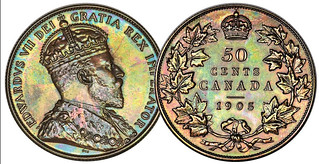 Cleaning can be disastrous to a coin’s value as evidenced with the sale of the George Cook Collection last August. Of the 439 lots, most of which were certified by Professional Coin Grading Service (PCGS), about 30 were re-certified with
either “cleaned,” “repaired,” “altered surfaces,” “surfaces smoothed” or “questionable colour” designations and given no numerical grade.
Cleaning can be disastrous to a coin’s value as evidenced with the sale of the George Cook Collection last August. Of the 439 lots, most of which were certified by Professional Coin Grading Service (PCGS), about 30 were re-certified with
either “cleaned,” “repaired,” “altered surfaces,” “surfaces smoothed” or “questionable colour” designations and given no numerical grade.
A 1905 specimen half-dollar (Lot 31299) re-certified as PCGS Uncirculated Details with an “altered surfaces” designation brought $3,360 US (about $4,475 Cdn.) – just six per cent of the $50,000 the collector originally paid for it before cleaning.
To read the complete article, see:
Five common coin problems and how to avoid them (https://canadiancoinnews.com/five-common-coin-problems-and-how-to-avoid-them/)
The Process For Submitting a Coin Design
Here's a Numismatic News article by Patrick Heller on the process for submitting a coin design to the U.S. Mint - not an easy or quick process. -Editor
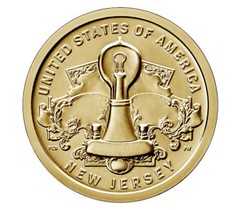 Anyone can send an email directly to the US Mint at inquiries@usmint.treas.gov. The email can be on any subject, including ideas for new coin designs. However, the US Mint does not initiate new commemorative coins or coin programs.
Instead, the Mint is required to strike coins specified in legislation passed by Congress and signed into law by the President.
Anyone can send an email directly to the US Mint at inquiries@usmint.treas.gov. The email can be on any subject, including ideas for new coin designs. However, the US Mint does not initiate new commemorative coins or coin programs.
Instead, the Mint is required to strike coins specified in legislation passed by Congress and signed into law by the President.
Mint officials in the last year or so have become more proactive at working with Congress on the details of pending coin bill language so as to try to remove onerous requirements and to have as much flexibility as possible at executing new coins. Thus, it is possible that the Mint’s liaison staff could express support to Congress for any possible new coin designs.
To read the complete article, see:
The Process For Submitting a Coin Design (https://www.numismaticnews.net/article/the-process-for-submitting-a-coin-design)
The Largest Book Ever Published
Dennis Tucker writes:
"AbeBooks has publicized the sale of the largest book ever published. File this under “F” --- for “Fun” or “Frightening,” or a little bit of both."
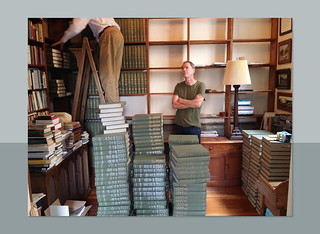 The National Union Catalog (NUC), Pre-1956 Imprints by Library of Congress and the National Union Catalog Subcommittee of the Resources Committee of the Resources and Technical Services Division, American Library Association,
$9,000
The National Union Catalog (NUC), Pre-1956 Imprints by Library of Congress and the National Union Catalog Subcommittee of the Resources Committee of the Resources and Technical Services Division, American Library Association,
$9,000
The largest book ever published. We are talking largest in terms of volumes - 754 heavy folio volumes bound in green cloth with gilt lettered spines - and weight, which is three tons. This is a reference book containing a list of books published before 1959 that were cataloged by the Library of Congress and other American libraries. Editors started compiling this book in 1909. This is the first and only edition. It contains around 530,000 pages and lists approximately 12 million titles. The Bible section alone contains 63,000 entries. The Shakespeare and Plato sections are also epic.
The NUC displays each entry with a reproduction of the Library of Congress' library card as well information gleaned from the original editions by librarians and additional notes added over the decades. An epic feat to produce and publish in 1968, this massive book is a tribute to American librarians, and perhaps the ultimate book about books. It was also an epic feat to ship this bad boy to its new owner. The NUC was transported to the buyer on palettes by a truck specially hired for the job.
Wow - that's a monster! I'm glad it found a new home. -Editor
To visit the AbeBooks web site, see:
https://www.abebooks.com/
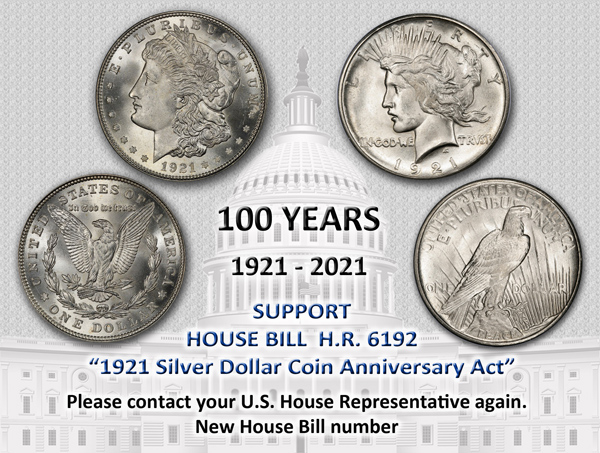
HOUSE BEAUTIFUL ON PENNY FLOORS
Why build a jigsaw puzzle you're only going to take apart again when you could use your spare time to give a room a more permanent numismatic touch? Here's a short article from House Beautiful on how people have paved their floors with pennies. -Editor
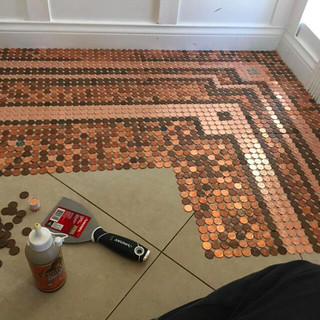 Pennies might be the least valuable coin, but that doesn't mean they can't shine. Even the dirty, darkened, and dated pennies still have some character. And with a little bit of superglue, these copper bits can really add up to
something valuable. Enter the penny floor!
Pennies might be the least valuable coin, but that doesn't mean they can't shine. Even the dirty, darkened, and dated pennies still have some character. And with a little bit of superglue, these copper bits can really add up to
something valuable. Enter the penny floor!
In 2015, Kelly Graham, owner of Etsy shop Camias Jewelry Designs, one-upped the concept of penny tile: She decorated her floor using 7,500 real pennies. At the news of Kat Von D's penny floor this week, Graham took to her store’s Facebook page to reminisce about her now 5-year-old (and still fully intact!) penny floor that she had DIY'd years before. "In a nutshell, the penny floor was a fun and cathartic project which I did back in 2015," she writes. Using both old and new pennies (and if you look closely, just a few dimes to complement the copper), Graham arranged each coin to create her own variegated mosaic floor. After gluing each cent in place, she grouted the floor and coated it off with clear resin on top. "I've got a few kids and it still looks in top shape," she says, speaking to the floor's durability.
Graham revealed that from start to finish the entire project took her "about 3 weeks." However, she did go back and forth on the floor's center design before finalizing. When a user asked how she acquired so many shiny pennies, Graham noted that she had gotten her pennies in rolls from the bank. She then went on to sort all her coins out, pieced together the mosaic pattern on the floor, and then glued each bit down.
To read the complete article, see:
This Woman Decorated Her Floor With 7,500 Pennies (https://www.housebeautiful.com/design-inspiration/a32407534/how-to-make-penny-floor/)
FEATURED WEB SITE: ROBERT A. SIEGEL AUCTIONS
This week's Featured Web Site is suggested by John and Nancy Wilson, who write:As all of us are virtually staying at home and working on our collections, libraries or other neglected or put off long overdue projects. Some years back Charles Opitz (Nancy's brother) gave to us a Robert A. Siegel auction catalog of Sale 955 held on April 11, 2008 and featuring "The Summit Collection of United States Encased Postage. As long time collectors of these and other related items we went to their site and were very pleased to find the prices realized for this sale.
The firm has been in business since 1930 and has held some important sales of numismatic postage and related items all of which are available to download and research. The Newman portal has references to the Siegel catalogs for items that have been purchased there. In any instance, if you collect U. S. postage currency, encased postage, postage stamp currency or postage currency envelopes you will have fun going through the various catalogs and finding items you collect along with what prices they realized.
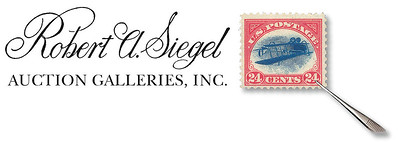
https://siegelauctions.com/

